Student Projects
More than 300 students from Notre Dame and universities around the world have participated in the NDnano Undergraduate Research Fellowship (NURF) program since it began in 2009. Each year, the students recap their summer research projects. Below you can find project summaries from those who have been part of the program for the last several years.
Set filter to current or past year.
Adaptive federated learning for sustainable, secured, and robust distributed intelligence: Algorithm and hardware co-design (James Boumalhab)
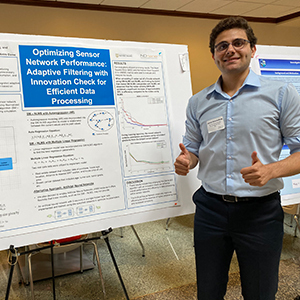
Sensors play a crucial role in collecting and transmitting data from the environment. However, they can go beyond data collection, e.g., sensor nodes can process data. To make data processing more efficient, the SM-NLMS adaptive filtering algorithm is employed to reduce unnecessary updates of filter parameters. Through MATLAB simulations, we observed up to 35% fewer updates with the innovation check. The algorithm showed fast convergence and improved data processing efficiency. Our research emphasizes the benefits of adaptive filtering with an innovation check, optimizing sensor networks.
James Boumalhab • University of Notre Dame
Professor Yih-Fang Huang • Electrical Engineering
Professor Ningyuan Cao • Electrical Engineering
Adiabatic capacitive logic and clocking systems for ultra-low power electronics (Daniel Noronha)
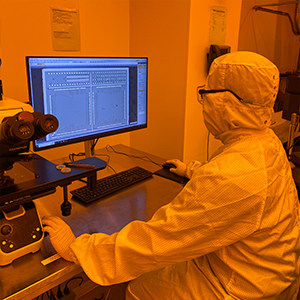
Adiabatic capacitive logic provides an alternative implementation of digital logic gates (to standard CMOS) by eliminating the issues of subthreshold leakage current in NMOS and PMOS transistors and minimizing heat dissipation from switching power supply clocks. This is achieved by using voltage-controlled variable capacitors implemented through MEMS (microelectromechanical structures) rather than MOSFETs, and by using linear ramping clocks in a Bennett clocking scheme (ramping time >> RC) with reversible logic rather than instantaneously switching clocks.
Daniel Noronha • University of Notre Dame
Professor Gregory Snider • Electrical Engineering
Professor Alexei Orlov • Electrical Engineering
Biocompatible membrane coated nanoelectrode for sweat analyte measurements (Sofia Granieri)
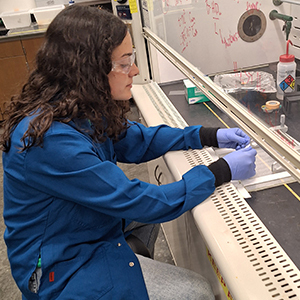
Proteins and other molecules present in biofluids can non-specifically adsorb onto sensor surfaces, reducing their performance. Studies have shown that membranes functionalized with zwitterions exhibited antifouling characteristics. In this project, permeabilities of functionalized and nonfunctionalized membranes were characterized and demonstrated that surface functionalization can affect the way membranes interact with species in solution. Further protein diffusion tests and spin coating for thinner membranes will give insight to design a better bio interface with antifouling properties and long-lasting method for attaching membranes onto sensor surfaces.
Sofia Granieri • University of Notre Dame
Professor Kaiyu Fu • Chemistry and Biochemistry
Professor William Phillip • Chemical and Biomolecular Engineering
Development of an aptamer based gold nanoparticle biosensor for the detection of kanamycin (Charlie Desnoyers)
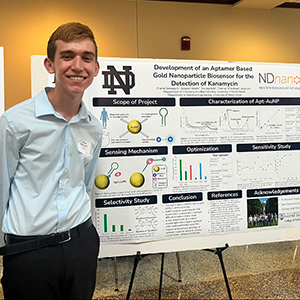
I have developed an aptamer-linked gold nanoparticle (Apt-AuNP) biosensor that allows for the detection of kanamycin via fluorescence measurements. By using gold nanoparticles as a quenching agent, fluorophore conjugated aptamers can be attatched to AuNP which allows for a sensitive signal to be seen. I synthesize, characterize, and measure the Apt-AuNP to understand their behavior with and without the addition of kanamycin. While a linear range was not achieved, signal was seen with nanomolar levels of kanamycin.
Charlie Desnoyers • University of Notre Dame
Professor Kaiyu Fu • Chemistry and Biochemistry
Professor Thomas O’Sullivan • Electric Engineering
Electrochemical synthesis of metal-organic frameworks for use in a nano-enabled electronic nose (Laura Schaffler)
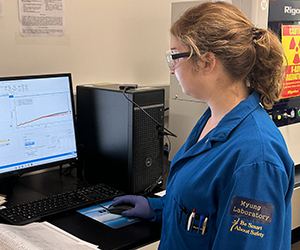
Metal-organic frameworks (MOFs) have recently been studied and synthesized for implementation in gas sensing technology due to their high surface area, tunable morphology, and electrical properties of semiconducting materials. For my project, I have been synthesizing MOFs under different temperatures, applied voltages, and solvents using the method of anodic deposition for further use in gas sensing application, specifically for use in an electronic nose.
Laura Schaffler • University of Notre Dame
Professor Nosang Myung • Chemical and Biomolecular Engineering
Electron paramagnetic study of spinel oxides (Hongkai Lou)
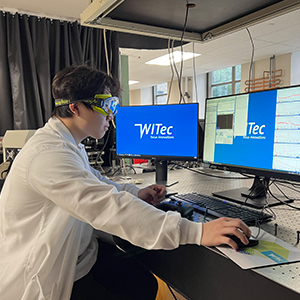
Doped spinel oxides can emit visible or infrared light under the excitation of X-ray photons, and the emission can last up to several hours and is called long lasting photoluminescence (LLP). To accomplish a longer period of LLP, our project focuses on synthesizing undoped and doped spinel oxides hydrothermally and analyzes their crystal structure, possible defect, and surface termination using raman microscopy, photoluminescence spectroscopy, EPR, and X-ray diffraction analysis.
Hongkai Lou • UCLA
Professor László Forró • Physics and Astronomy
Dr. Dávid Beke • Physics and Astronomy
Glucose responsive molecule library (Grace Hartzer)
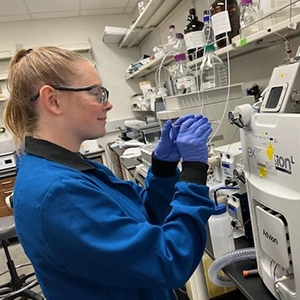
Carbohydrate receptor molecules open up a world of potential for combating various diseases, antibiotic resistant bacteria, and even diabetes. The Webber lab is seeking to identify different glucose-binding molecules to assist in the aid of insulin delivery to type one diabetes patients.
Grace Hartzer • University of Notre Dame
Professor Matthew Webber • Chemical and Biomolecular Engineering
High frequency response of thermoelectrically coupled nanoantennas (Jeffrey Yang)
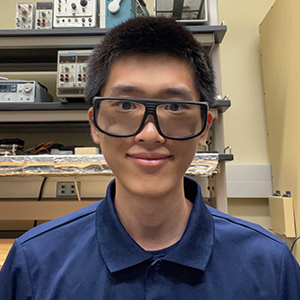
This work investigates the frequency response of dipole and spiral thermoelectrically coupled nanoantennas (TECNAs) in vacuum. TECNAs are polarization- and wavelength-selective long-wave infrared (LWIR) detectors. Theory predicts that in vacuum, TECNA responsivity increases, while speed decreases. An acousto-optic modulator (AOM) is used to modulate the optical input signal to frequencies up to 100 kHz. Measurements of dipole and spiral TECNAs match theory. In addition, the extinction ratio of spiral TECNAs is found to be lower in vacuum.
Jeffrey Yang • University of Notre Dame
Dr. Gergo Szakmany • Electrical Engineering
Magneto-silica nanoparticles (MagSiNs) for combinatorial chemotherapeutics and gene delivery against metastatic cancers (Kevin Armknecht)
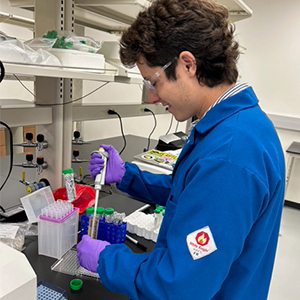
Antibiotic resistance is a rapidly expanding problem faced in healthcare today as bacteria have evolved resistance to commonly used antibiotics. Data from Minimum Inhibitory Concentration (MIC) and Zone of Inhibition studies are valuable in determining the increased efficiency of nanoparticles in comparison to antibiotics versus drug-resistant bacteria. The Evolution of Resistance project I completed can provide further insight to whether nanoparticles are a viable alternative to currently used antibiotics.
Kevin Armknecht • University of Notre Dame
Professor Prakash Nallathamby • Aerospace and Mechanical Engineering
Micro-organoids by gel droplet platform for cancer drug screening (Angela Taglione)
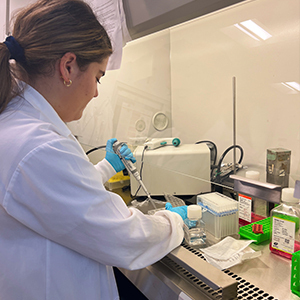
3D cultures like spheroids are used to represent the tumor’s microenvironment; however, production is limited due to time consumption and reproducibility. To solve this issue, we evaluated the production of microgels using an elliptical pipette for cell encapsulation by droplet emulsion. Good cell viability, increased cell proliferation, and successful infiltration of large-sized molecules into the porous gaps of the microgel suggest successful creation of an reproducible and inexpensive gel-droplet platform for high-throughput cancer drug screening.
Angela Taglione • University of Notre Dame
Professor Donny Hanjaya-Putra • Aerospace and Mechanical Engineering
Nanoparticle Dox.HCl treatments on triple-negative breast cancer cells (Jichong Lyu)
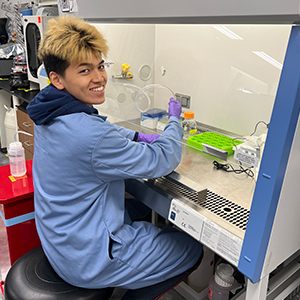
Dox.HCl nanoparticle, by delivering chemotherapeutic drugs to tumor location, have been proven to increase killing efficiency on MDAMB231, a Caucasian triple-negative breast cancer cell line, and have limited side-effects [2]. My research focuses on applying Dox.HCl to breast cancer cell lines from other ethnic groups and compare the effectiveness. Our result should contribute to a more comprehensive understanding of the nanoparticle treatment and shed light on reducing medical inequality among ethnic groups.
Jichong Lyu • University of Notre Dame
Professor Prakash Nallathamby • Aerospace and Mechanical Engineering
Nanoparticle-mediated reprogramming of cells to fight cancer (Monica Leal Palma)
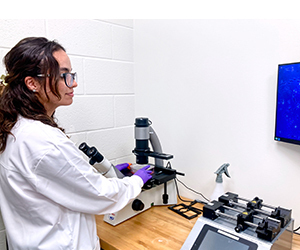
Fibroblasts are important for maintaining the structure and function of tissues, but when cancer signals are present, they can adopt an activated phenotype marked by the expression of different biomarkers. These cancer-associated fibroblasts (CAFs) are an abundant component of the tumor microenvironment (TME) in many solid tumors, and are known to promote tumor progression, metastasis, immunosuppression, and treatment resistance. The objective of this study is to investigate fluorescein isothiocyanate labeled silica (FITC-SiO2) nanoparticles (NPs) as a platform for engineering fibroblast-specific antibodies to enable targeting and reprogramming of CAFs into a tumor-restraining state.
Monica Leal Palma • Universidad de las Américas Puebla (UDLAP)
Professor Meenal Datta • Aerospace and Mechanical Engineering
Professor Ryan Roeder • Aerospace and Mechanical Engineering
Nanoscale formulation of corrective hormones for blood glucose control (Elizabeth Power)
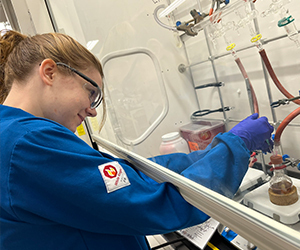
The GLP-1 delivery was designed such that function would be suppressed when blood glucose levels were low. Successful synthesis of the peptide was verified through mass spectroscopy, and assays were performed to determine glucose-responsible structural and functional properties. Success in producing a glucose-responsible GLP-1 delivery method would introduce a safer therapeutic for individuals with type 2 diabetes, allowing for improved glycemic control.
Elizabeth Power • University of Notre Dame
Professor Matthew Webber • Chemical and Biomolecular Engineering
Polymers in next-generation rechargeable batteries (Katherine Zinkan)
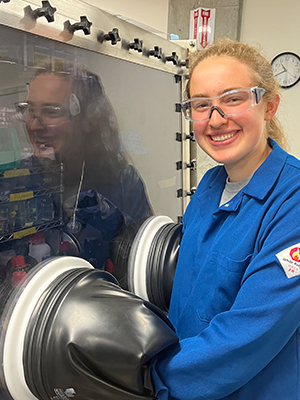
Lithium sulfur batteries with solid polymer electrolytes are potential future-generation devices for energy storage due to sulfur’s high energy density and affordability. Additionally, solid electrolytes have improved safety. However, polysulfides, lithium sulfur battery reaction intermediates, move through the electrolyte which decreases the charge capacity of these batteries. This work focuses on making a polymer interlayer within the electrolyte to block polysulfide movement. This allows more sulfur utilization during battery discharge to maintain the energy dispensed during each cycle.
Katherine Zinkan • University of Notre Dame
Professor Jennifer Schaefer • Chemical and Biomolecular Engineering
Polymers in next-generation rechargeable batteries (Peter Schimpf)
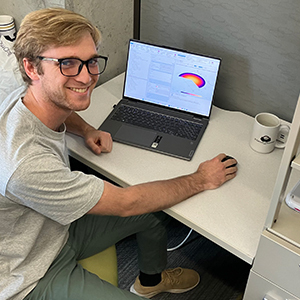
Typical lithium-ion batteries use organic liquid electrolytes, which are highly volatile. The use of gel polymer electrolytes has been studied to increase the safety of lithium-ion batteries by decreasing the propensity of thermal runaway. COMSOL Multiphysics was used to create a simplified model of thermal runaway in a lithium-ion coin cell. The simplified model will be used to understand the effect of using a gel polymer electrolyte in place of a conventional liquid electrolyte.
Peter Schimpf • University of Notre Dame
Professor Jennifer Schaefer • Chemical and Biomolecular Engineering
Pursuing superconductivity in novel low-dimensional materials (Lili Vajtai)
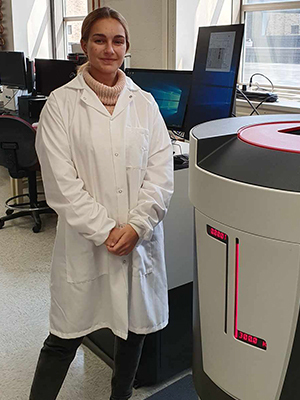
Transition metal dichalcogenides (TMDCs) are known for having a layered structure that makes it easy to perform exfoliation and intercalation on them. The effect of these procedures has been previously studied separately and it has been found that both methods result in drastic changes in the electronic, optical, and mechanical properties. The goal of the project was to study the effect of intercalation on exfoliated TMDCs with various thickness and their possibly occurring superconducting behavior.
Lili Vajtai • Budapest University of Technology and Economics
Professor László Forró • Physics and Astronomy
Dr. Bence Markus • Physics and Astronomy
Synthesizing gold hexagonal nanoplates under different lighting conditions (John Howe)
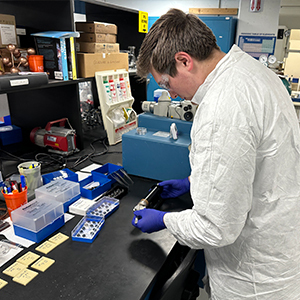
Controllable nanostructure formation shows promising applications in sensing and nanoelectronics. Gold hexagonal nanoplates are among some of the structures that show great promise in these evolving fields. Recent developments in the Neretina Lab have allowed for further control over the growth process. While interactions with basic LED room lights have been observed, little is known about how monochromatic light in different intensities may affect the growth process. We demonstrate two possible competing growth mechanisms are present when arrays of nanostructures are subjected to monochromatic irradiation at a controlled duration and intensity. These growth mechanisms shed light on the photochemical reactions occurring during the synthesis of gold nanoplates.
John Howe • University of Notre Dame
Professor Svetlana Neretina • Aerospace and Mechanical Engineering
Tailoring the electronic properties of Ti-based MXenes (Robin Kucsera)
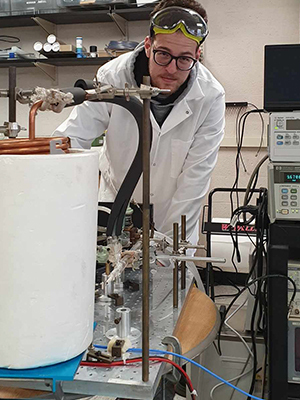
MXenes are a family of two-dimensional compounds that have been discovered recently. The properties of Ti3C2, as a novel material, are still not yet well-known. One of the key questions is how well we can introduce and accommodate metals into their composition to improve their electronic capabilities. The layered structure of the MXenes could serve as a good host for intercalation compounds. During the project, I tried vapor and liquid ammonia-based intercalation methods with potassium and calcium.
Robin Kucsera • Budapest University of Technology and Economics
Professor László Forró • Physics and Astronomy
Dr. Bence Markus • Physics and Astronomy
Understanding the interactions between non-equilibrium plasma and nanomaterials in a fluidized gliding arc (Maximilian Niebur)
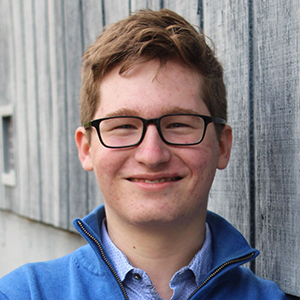
Gliding arc plasmas are a promising frontier in plasma catalysis research due to the high number of reactive species they generate and the amount of gas they can process. We constructed and parametrized a gliding arc to recycle gaseous hydrocarbons by reacting them with oxidants such as nitrogen to create organic compounds.
Maximilian Niebur • Johns Hopkins University
Professor David Go • Aerospace and Mechanical Engineering
Universal programmable entropy source for hyper-dimensional computing (Yiyang Zhang)
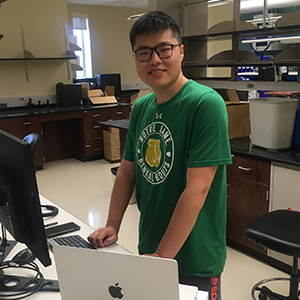
A topologically symmetric analog entropy generation source has been investigated, boasting small silicon area overhead and power consumption. Uniform, gaussian and gamma distribution can be interchanged via programming supply voltages. Monte-Carlo simulation results utilizing HSPICE meets well with theoretical calculation results from non-linear transformation theory, laying solid foundation for future tape-out verification.
Yiyang Zhang • University of Notre Dame
Professor Ningyuan Cao • Electrical Engineering
Adiabatic capacitive logic (ACL) for ultra-low power electronics (Abigail Brown)
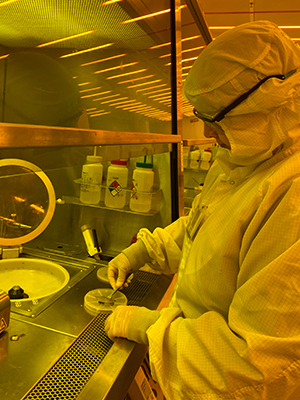
Conventional CMOS technology speeds are ultimately limited by heat dissipation. Adiabatic CMOS operations have been implemented to mitigate this dissipation, but it is limited by passive power dissipation caused by unavoidable leakage current. Adiabatic capacitive logic (ACL) utilizes variable capacitors to eliminate leakage current. By switching circuits quasi-adiabatically (by using linear ramps with a raise/drop time that is larger than its intrinsic RC time constant), the active power can be reduced, and less heat is dissipated with energy savings up to 50%. Even greater reduction in power dissipation can be achieved by using reversible computing.
Abigail Brown • Saint Mary’s College and University of Notre Dame
Professor Gregory Snider • Electrical Engineering
Professor Alexei Orlov • Electrical Engineering
Adiabatic capacitive logic for ultra low-power electronics (AnnahMarie Behn)
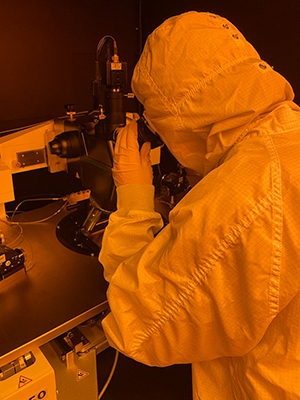
Quasi-adiabatic reversible capacitive logic uses reversible logic and linear ramping to recycle energy. By utilizing this combination, pull-in and pull-out voltages change gradually instead of instantaneously, minimizing heat dissipation as the capacitor charges. From this concept, we researched the design and nanofabrication of adiabatic capacitive logic devices designed with a voltage-controlled MEMs variable capacitor structure. These ACL devices are fundamentally free of passive power dissipation, so there is potential for more definitive output capacitance change in future iterations.
AnnahMarie Behn • University of Notre Dame
Professor Gregory Snider • Electrical Engineering
Professor Alexei Orlov • Electrical Engineering
Computation modeling for homomorphic encryption in privacy-preserving vehicular network (Jeremy Stevens)
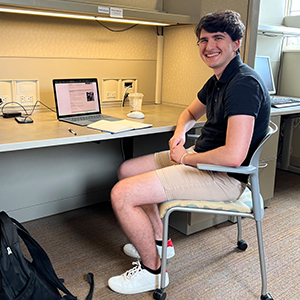
The aim of this project is to decrease computational cost of homomorphic encryption by developing an encryption model to implement improved algorithms. Models for BFV and CKKS encryption schemes were developed and tested. Accelerated algorithms such as Barrett Reduction and the Number Theoretic Transform were implemented, and the respective gains for each were recorded.
Jeremy Stevens • University of Notre Dame
Professor Ningyuan Cao • Electrical Engineering
Dendrimer synthesis for nanoscale glucose-responsive assemblies (Salmady Ramos Valentín)
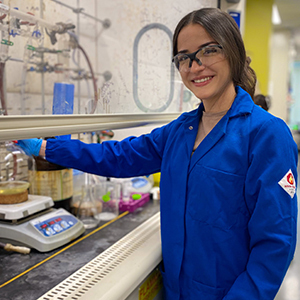
Dendrimers are structurally ordered, multifunctional, and highly branched polymeric molecules. Here, we seek to design dynamic-covalent crosslinked hydrogel materials using dendrimer building blocks containing PBA-diol conjugates to sense and respond to high glucose levels to release an accurate amount of encapsulated insulin. Dendrimers are a great candidate for these materials thanks to their high number of functional groups and their controlled, simple, defect-free, cost-effective synthesis.
Salmady Ramos Valentín • University of Puerto Rico Mayagüez
Professor Matthew Webber • Chemical and Biomolecular Engineering
Electrochemical analysis of hybrid bronzes (Bennett Schmitt)
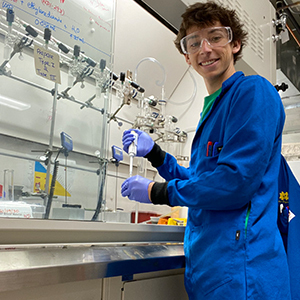
“Bronzes,” aptly named for their lustrous surfaces resulting from high concentrations of free electrons, are inorganic metal oxides exhibiting high chemical and thermal stability, as well as tunable electronic properties. However, this class of materials often requires energy-intensive synthetic routes and lacks post-synthetic tunability. Conversely, molecular species offer fine synthetic control, while lacking the structural and electronic properties seen in bronzes. Thus, the combination of inorganic metal oxides and organic species allows for the synthesis of a novel material platform, known as “hybrid bronzes,” that combines the advantageous properties of each. This work focuses on the electrochemical analysis of these bronzes and hybrid bronzes to investigate their redox behavior with the intention of informing future implementation efforts in clean-energy technologies.
Bennett Schmitt • University of Notre Dame
Professor Adam Jaffe • Chemistry and Biochemistry
Enhancement of gas sensing performance based on controlled synthesis of heterojunctions and addition of noble metal dopants in WO3 nanofibers (Zuánichi Figueroa Hernández)
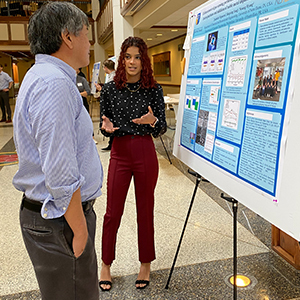
Gas sensors are extremely relevant for the detection of gas analytes surrounding us. Among different metal oxide semiconductor sensing materials, WO3 is one of the best choices because of its low-cost, highly stable, sensitive, and acceptable selectivity. By synthesizing heterojunctions between two dissimilar MOS sensing materials and the addition of noble metal dopants to WO3, it would be possible to enhance the sensitivity of MOS nanofibers toward analytes.
Zuánichi Figueroa Hernández • Polytechnic University of Puerto Rico
Professor Nosang Myung, Chemical and Biomolecular Engineering
Far-field characterization of infrared nanoantenna detectors (Luke Strachan)
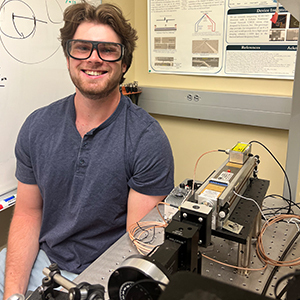
Semiconductor based infrared detectors, bolometers, and traditional thermocouples used for measuring infrared radiation either need to be cooled or their response time is slow. A new alternative is the use of thermoelectrically coupled nanoantennas (TECNAs) that utilize the Seebeck effect to generate a response to a signal that can have directional, polarization, and wavelength selective properties all while being an uncooled, sensitive device. Further testing of these TECNAs will allow for improved measurement devices in areas such as solar research.
Luke Strachan • University of Notre Dame
Professor Gergo Szakmany • Electrical Engineering
First-principles calculations of thermoelectric properties in monometallic nanothermocouples (Justin Share)
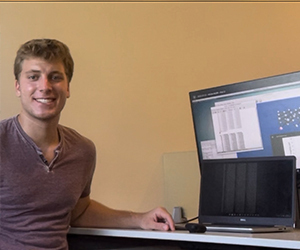
NASA infrared sensors are powered by thermocouples which translate a difference in heat into an output voltage. This output voltage is determined by the properties of the metals that make up the thermocouple. This project aims to perform calculations that will provide the thermoelectric properties of different materials. These properties, such as the Seebeck coefficient and thermal conductivity, will discover which materials create the best thermocouples and improve the sensitivity of the infrared sensors.
Justin Share • University of Notre Dame
Professor Gary Bernstein • Electrical Engineering
Professor Erik Blair • Electrical and Computer Engineering (Baylor University)
Glucose responsive glucagon for hypoglycemia rescue (Belen Flores)
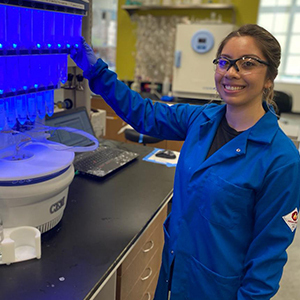
This project focuses on synthesizing a glucose responsive material as a preventative strategy for hypoglycemia rescue by incorporating glucose-sensing functionality into glucagon delivery. Zeta potential measurements and turbidity tests suggest resulting approaches have glucose-responsive function. However, further improvements must be made to increase sensitivity and ensure function. Future work thus will seek to improve glucose responsiveness and determine its efficacy in diabetic mice under severe hypoglycemia.
Belen Flores • Saint Mary's College and University of Notre Dame
Professor Matthew Webber • Chemical and Biomolecular Engineering
Investigation of thermoelectrically coupled nanoantennas in a vacuum setting (Collin Finnan)
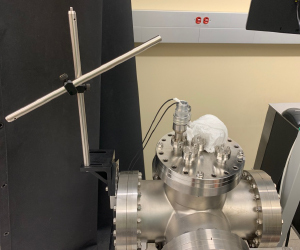
The focus of this project is to explore and quantify the performance improvements of thermoelectrically coupled nanoantennas (TECNAs) while in a vacuum setting. The electrical signal measured on these chips is due to the Seebeck effect, where an open-circuit voltage is generated by a temperature difference between the antenna’s hot center and the “cold” substrate, connected by two dissimilar metal lead lines [6]. Heat losses due to air cause a reduction in signal strength, meaning theoretically the TECNAs will improve in the absence of air.
Collin Finnan • University of Notre Dame
Professor Gary Bernstein • Electrical Engineering
IPSC to LEC transfection utilizing ETS2 and ETV2 (Francine Graham)
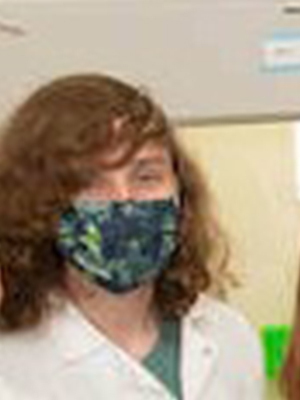
Stem cells have the capacity to become a range of other cells through various processes. Among those processes is utilizing the capacities of lentiviruses to modify the RNA of host cells. Of the existing lentiviruses, ETS2 and ETV2 have been shown to result in endothelial-like cells, which is shown in expression of particular endothelial cell markers. The particular cell marker which this project sought to express was Prox1, an intercellular marker of LECs, which did appear to be present.
Francine Graham • University of Notre Dame
Professor Donny Hanjaya-Putra • Bioengineering
Molecular simulation to enable the recycling of hydrofluorocarbon refrigerants (Edwin Velez Ortiz)
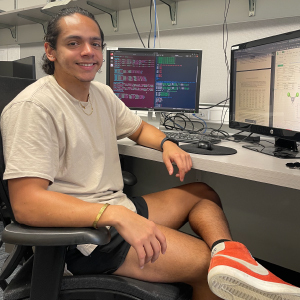
In this work, classical molecular simulations were employed by applying the Gibbs Ensemble Monte Carlo (GEMC) method to compute the phase diagram of pure hydrofluorocarbons. These simulations were performed using model parameters collected from existing literature with the purpose of generating a benchmark of the current available molecular models. The results of this research will contribute to the development of optimized molecular models capable of simulating vapor-liquid equilibrium for a variety of HFCs.
Edwin Velez Ortiz • University of Puerto Rico, Mayagüez
Professor Edwin Maginn • Chemical and Biomolecular Engineering
Nanocatalytic membranes for water treatment (Aaron Peaslee)
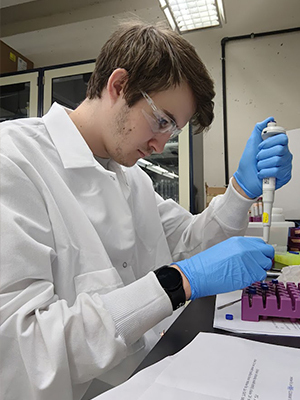
Nanocatalytic membranes have been fabricated that utilize palladium nanoparticles as a catalyst for H2 and oxidized contaminants in water (e.g., NO2-). Previously, the cost of palladium has made the process of creating these types of membranes prohibitively expensive, but by adsorbing the palladium onto the membrane as nanoparticles costs are cut down significantly, making nanocatalytic membranes a competitive option for water treatment to remove contaminants.
Aaron Peaslee • Michigan Technological University
Professor Kyle Doudrick • Civil and Environmental Engineering and Earth Sciences
Nanoparticle carriers for novel anti-Leishmanial chemotherapeutics (Julia Gattozzi)
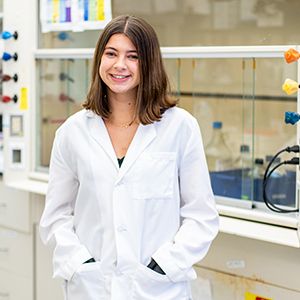
Leishmaniasis is a neglected tropical disease caused by protozoan parasite leishmania spp. Gold nanoparticles (AuNPs) have been explored as a drug delivery system to reduce cytotoxicity and improve bioavailability of chemotherapeutics for leishmaniasis. We engineered ~13nm amphiphilic AuNPs and loaded AuNPs with a novel anti-leishmanial chemotherapeutic. Drug-loaded AuNPs were screened for potency against L.donovani promastigotes and cytotoxic effects on THP-1 macrophages. The 50% inhibitory concentration was ~5-10μM and drugloaded AuNPs demonstrated minimal cytotoxicity up to 50μM.
Julia Gattozzi • University of Notre Dame
Professor Ryan Roeder • Aerospace and Mechanical Engineering
Professor Mary Ann McDowell • Biological Sciences
Phononic nanoparticles for low-loss, tunable nanophotonics in the mid- and far-IR (Juwan Jeremy Jacobe)

ZnO nanoparticles exhibiting surface phonon polariton (SPhP) modes between 600cm-1 and 400cm-1 were synthesized using a solvothermal method to investigate applications for molecular sensing in the mid- and far-IR. Thymine, the analyte-of-interest, was adsorbed onto the nanoparticles’ surface, and the IR spectra of adsorbed samples were measured using FTIR spectroscopy. Thymine adsorbed on ZnO nanoparticles displayed new/enhanced spectral features between 1300cm-1 to 1100cm-1, potentially due to interactions with the second harmonic of SPhP modes.
Juwan Jeremy Jacobe • University of Notre Dame
Professor Anthony Hoffman • Electrical Engineering
Professor Ryan Roeder • Aerospace and Mechanical Engineering
Polycationic polymer carrying phage-mimicking antibacterial nanoparticles as infection preventing coatings for metal alloy implants (Conor Sheehan)
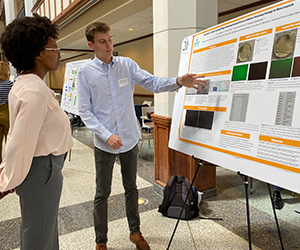
Due to bacteria developing a resistance to antibiotics, medical implant surgeries have an increased rate of infection. This project focused on determining if nanoparticles linked with polycationic polymers have an antibacterial effect when placed on implants while also testing the particles for their biocompatibility.
Conor Sheehan • University of Notre Dame
Prakash Nallathamby • Aerospace and Mechanical Engineering
Polymers in next-generation rechargeable batteries (Sam Chen)
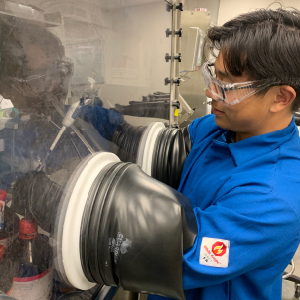
Electrolytes enable a battery to function by enabling the movement of ions between the electrodes. However, commercially used electrolytes are carbon-based and have high risks of causing fire hazards. My project focuses on reducing such risks by adding perfluoropolyether diacrylate to our electrolytes. Conductivity and potential stability were measured for different weight percent of polymers added to select the optimal composition.
Sam Chen • University of Notre Dame
Jennifer Schaefer • Chemical and Biomolecular Engineering
Realization and detection of topological superconductivity (Maximilian Niebur)

Topological phases feature physical observables being related to topological invariants. The most prominent example is the Chern number, which relates the conductance of the quantum Hall state to the integral of the Berry curvature over the Brillouin zone. There are many other such topological phases, including the newly discovered field of topologic superconductors. I worked to understand theories about the nature of such materials, and how they may be realized.
Maximilian Niebur • Johns Hopkins University
Professor Yi-Ting Hsu • Physics and Astronomy
Scalable nanofabrication of metasurfaces using microsphere photolithography (Aldo Celis Cordova)
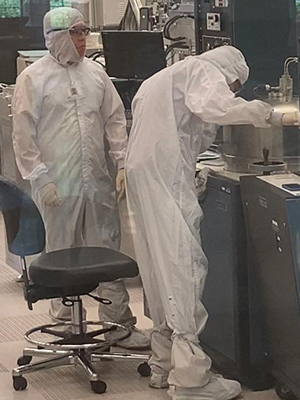
Creating a nanoscale hole array for infrared sensors can be expensive when conventional e-beam lithography or focused ion-beam milling are used. Therefore, microspheres are exposed to UV light to act as a microlens and, as a result, achieve nanoscale photolithography. This new technique can significantly reduce the cost for nanofabrication and can scale up the process (wider areas can be exposed with a single exposure).
Aldo Celis Cordova • Monterrey Institute of Technology and Higher Education
Professor Ed Kinzel • Aerospace and Mechanical Engineering
Scalable nanomanufacturing and hybrid printing of multifunctional devices (Stephanie Atampugre)
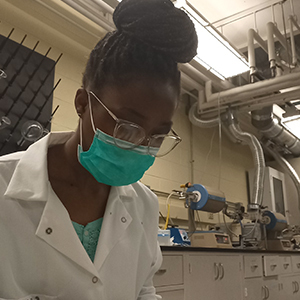
Conventional fabrication methods for integrated sensors involve manufacturing the sensors separately before integrating them into one device, a process which is complex, labor-intensive and time-consuming, making these integrated sensors cost-inefficient. Aerosol jet printing presents a fabrication process that is much more simplified with the ability to print on conformal substrates to produce flexible, micro-scale multifunctional sensors. Indium tin oxide (ITO) and gold’s high thermal stability, conductivity and relatively high Seebeck coefficient when employed in thermocouple temperature sensing make them ideal for the fabrication of an integrated sensor for simultaneous strain and temperature sensing, sensing up to 550℃.
Stephanie Atampugre • University of Notre Dame
Professor Yanliang Zhang • Aerospace and Mechanical Engineering
Single electron transistors (SETs) on SiN membranes for measuring quantum dots (Moboluwagbe Adesanmi)
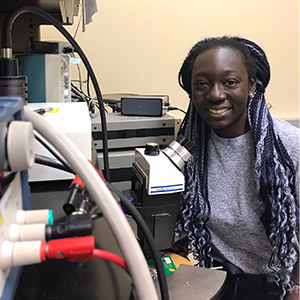
Single electron transistors (SETs) are the most sensitive charge detectors demonstrated to date. Scanning SET methods are intended for use to measure composite fermion and Majorana zero mode states in quantum electron droplets (QEDs), which could be useful for the realization of fault tolerant topological quantum computing. A SET based scanning probe system can be implemented by fabricating SETs on a silicon nitride (SiN) membrane to be used as a probe tip for an atomic force microscope.
Moboluwagbe Adesanmi • Villanova University
Professor Greg Snider • Electrical Engineering
Professor Alexei Orlov • Electrical Engineering
Squeezing light into small volumes using gold nanoparticles (Ana Corcoran)
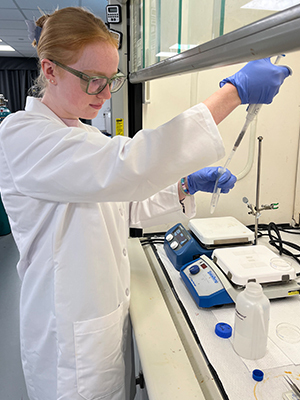
Gold nanoparticles (AuNPs) exhibit size-dependent properties that have applications in catalysis and sensing. This is due to the nanogap that is formed when the distance between two AuNPs decreases. The nanogaps were produced using two types of AuNPs, substrate-immobilized and colloidal. It was found that as the size of the colloidal AuNPs grew past 15 nm, it became more difficult to attach them to the substrate-immobilized AuNPs via the linkers used.
Ana Corcoran • Saint Mary's College
Professor Svetlana Neretina • Aerospace and Mechanical Engineering
Ultrafast laser processing for surface texturing (Brianna Dewey)
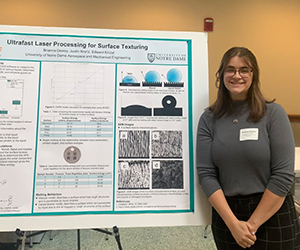
Contact angle measurements and surface energy calculations are two ways to characterize the wettability of liquids on a surface. The objective of this project is to adjust the texture of a surface using ultrafast laser techniques and observe how the water contact angle measurements change as a result of the input parameters. An additional aim is to manufacture a surface that shows low wettability and hydrophobicity as a result of the laser texturing.
Brianna Dewey • Saint Mary's College and University of Notre Dame
Professor Ed Kinzel • Aerospace and Mechanical Engineering
Adiabatic capacitive logic for ultra-low power electronics (Abigail Brown)
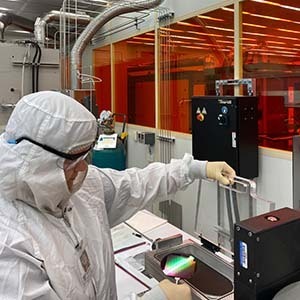
Reversible computing is an approach that uses virtually adiabatic transitions and reversibility in order to mitigate heat dissipation. This is in a way similar to recycling of home waste – instead of throwing energy into heat adiabatic reversible logic aims at recycling energy. Implementations of reversible computing in modern CMOS circuits proved that there were still limits to the passive power dissipation. Adiabatic Capacitive Logic (ACL) is a possible implementation of reversible computing that uses variable capacitors in pull-up and pull-down networks that isn’t limited to passive power and can recover 99.1% of its energy usage.
Abigail Brown • Saint Mary's College and University of Notre Dame
Professor Greg Snider • Electrical Engineering
Professor Alexei Orlov • Electrical Engineering
Adiabatic capacitive logic for ultra-low power electronics (Jacob Gose)
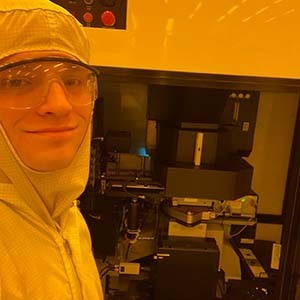
The speed at which current logic devices, such as CMOS transistors, operate is limited by heat dissipation. Possible solutions studied include new types of operation, such as adiabatic CMOS, and devices, such as microelectronic mechanical structures (MEMS). Adiabatic capacitive logic combines principles of other solutions into a novel approach for creating ultra-low power electronics, based off variable capacitor networks. This project focused on the fabrication of such devices.
Jacob Gose • University of Notre Dame
Professor Greg Snider • Electrical Engineering
Professor Alexei Orlov • Electrical Engineering
Adsorption of luminescent probe on a porous surface for luminescent sensor development (Nicholas Slusher)
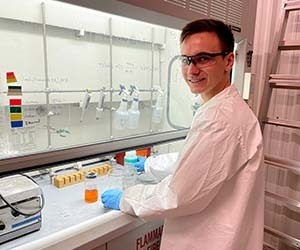
During the production of AA-PSP, anodized aluminum is submerged into a solution containing the luminophore. It is necessary to understand the effect of temperature during the dipping process has on the characteristics of the AA-PSP. The results demonstrated that a change in solution temperature affects pressure sensitivity, temperature sensitivity, and intensity. The amount of variability and possible error throughout the collected data was high. Therefore no clear trend could be established. The findings demonstrate that this area of study is promising though more refinement to testing methodology is required.
Nicholas Slusher • University of Notre Dame
Professor Hirotaka Sakaue • Aerospace & Mechanical Engineering
Binding of per- and polyfluoroalkyl substances (PFAS) to cucurbit[7]uril (Jackson Vyletel)
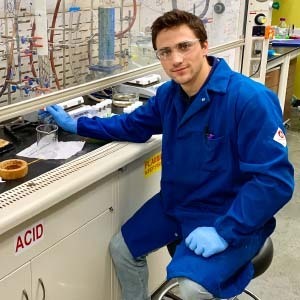
Per- and polyfluoroalkyl substances (PFAS) have become increasingly problematic for health and the environment. This work demonstrates novel capture and detection of various PFAS molecules. We test multiple PFAS under varying pH conditions and model their respective association constants (Ka), showing technologies that capture PFAS with sufficient binding affinity. This shows promise for the applications of non-covalent binding of PFAS, with future sights set on industrial capture technologies for remediation of waste water and streams.
Jackson Vyletel • University of Notre Dame
Professor Matthew Webber • Chemical & Biomolecular Engineering
Characterization of triple junction-enhanced thermally-driven plasma on the surface of pyroelectric crystals (Kathleen Hart)
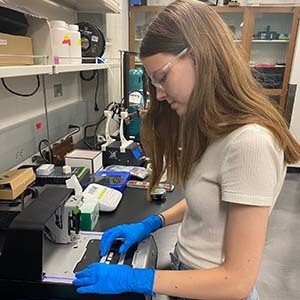
Low temperature non-equilibrium plasmas can be produced by pyroelectric crystals if they are exposed to a significant temperature gradient, what is termed an energy-conversion plasma source. The addition of a triple junction, a feature where a metal, dielectric and air meet, on the surface of the crystal enhances the electric field that produces these plasmas. This project focuses on characterizing thermally-driven plasmas enhanced by triple junctions by analyzing their dependence on distance and angle.
Kathleen Hart • University of Notre Dame
Professor David Go • Aerospace & Mechanical Engineering
Controlling gold nanostructure dimensions using an etching solution (Hailey Meyer)
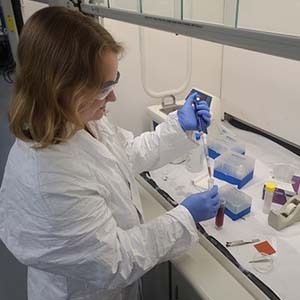
Substrate-bound gold nanostructures provide enhanced chemical and biological sensing, offering increased sensitivity for spectroscopic analysis. The nanostructure morphology can be controlled through an etching solution to exert control on the particles post-synthesis. The etching solution, when applied to seeds, did not destroy the growth potential but encouraged rounded structures when regrown. When the solution was applied to nanoplates, the etch did not remove the gold from a specific side, but evenly across the surface.
Hailey Meyer • Saint Mary's College and University of Notre Dame
Professor Svetlana Neretina • Aerospace & Mechanical Engineering
Data-enabled optimization for printing chemical patterns on nanostructured membranes (Alexander Perez)
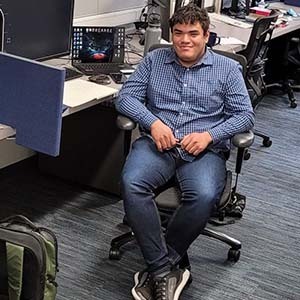
Modeling kinetics of the copper (II)-catalyzed azide-alkyne cycloaddition(CuAAC) reactions using numerical methods and python code combined with experimental data to produce a model capable of reproducing behaviors observed in the laboratory with minimal errors, enabling the computational optimization for the design of reactive inks. [6] [7]
[6] E. V. Shtamm, A. P. Purmal, and Y. I. Skurlatov, “Mechanism of catalytic ascorbic acid oxidation system Cu2+–ascorbic acid–O2,” Int. J. Chem. Kinet., vol. 11, no. 5, pp. 461– 494, 1979, doi: 10.1002/kin.550110503.
[7] C. Intermediate, “Direct Evidence of a Dinuclear,” vol. 340, no. I, pp. 457–461, 2010.
Alexander Perez Reyes • University of Puerto Rico, Mayaguez
Professor Alexander Dowling • Chemical & Biomolecular Engineering
Professor William Phillip • Chemical & Biomolecular Engineering
Developing glucose responsive microneedles for insulin delivery (Thomas Monroe)
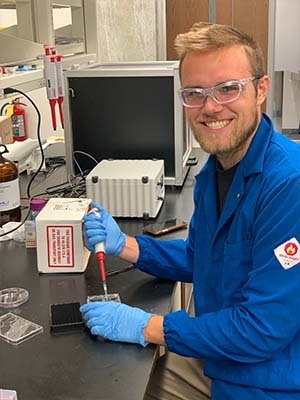
Phenylboronic Acid (PBA) has demonstrated an affinity to bind with 1,2 and 1,3 cis diols, including glucose. This project aims to form a dynamically crosslinked hydrogel between a polymer chain containing a PBA, and a separate diol unit. The properties of this gel are altered in the presence of glucose, leading to the release of insulin that was stored within the mesh of the original gel.
Thomas Monroe • University of Notre Dame
Professor Matthew Webber • Chemical & Biomolecular Engineering
Development of polymeric piezo-electrolytes for self-charging batteries (Nathaniel Moller)
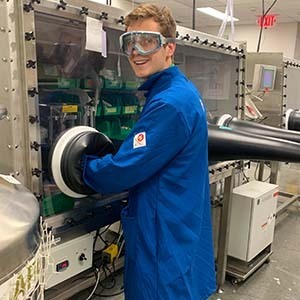
Typically, energy generation and storage are two distinct processes that occur in different entities. In this project, the two processes are coupled together where mechanical energy is converted into electrical energy and then stored as chemical energy to create a self-charging battery. More specifically, a charge will be generated across the piezoelectric separator when a stress is applied, and the polymer electrolyte will enable ion transport, converting the electrical charge generated from the piezoelectric into electrochemically stored energy.
Nathaniel Moller • University of Notre Dame
Professor Jennifer Schaefer • Chemical & Biomolecular Engineering
Engineering biomimetic materials to promote lymphangiogenesis (Erin Neu)
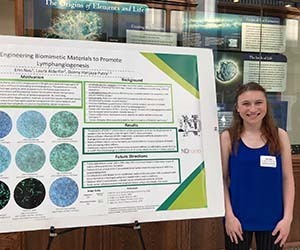
Lymphatic endothelial cells (LECs) encapsulated in HA gels portrayed the importance of vascular endothelial growth factor-C (VEGF-C) and matrix stiffness in controlling lymphangiogenesis. LECs encapsulated in 25%, 50%, or 75% crosslinked hydrogels o showed: the presence of VEGFR-3 and VEGF-C is imperative to lymphangiogenesis; matrix stiffness influences VEGFR-3 expression; and matrix stiffness impacts vessel formation. The results of these experiments catalyze future experimental directions to reach a practical applicable conclusion by aiding in the study of natural lymphangiogenesis mechanisms, which provide a platform to study tumor microenvironment lymphangiogenesis that will aid in the developed of a treatment for lymphedema in cancer patients and survivors.
Erin Neu • University of Notre Dame
Professor Donny Hanjaya-Putra • Aerospace & Mechanical Engineering
Generating continuous spark discharges through high-frequency mechanical actuation of piezoelectric crystals (Nicholas DeLuca)
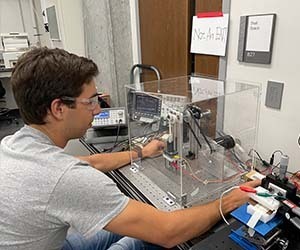
Plasmas are typically generated using a high voltage power supply, usually confining them to laboratory settings. The voltages induced by the mechanical deformation of piezoelectric crystals can be used to create filamentary spark discharge plasmas. This research focused on the design of a mechanical system to actuate piezoelectric crystals at high frequencies with the goal of creating usable continuous spark discharges.
Nicholas DeLuca • University of Notre Dame
Professor David Go • Aerospace & Mechanical Engineering
Magnetic nanocarrier based, precision combinatorial chemotherapeutics treatment against metastatic cancer cells (Qinxiao Wu)
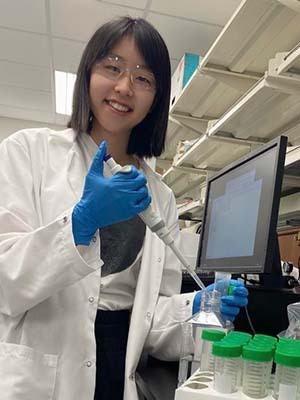
This project aims to target cancer cells by tuning the magnetic field-induced force exerted by label-free magnetic nanomaterials at the cell membrane to selectively permeabilize the more compliant cancer cell membranes but not the stiff healthy cell membranes.
Qinxiao Wu • University of Notre Dame
Professor Prakash Nallathamby • Aerospace & Mechanical Engineering
Professor Paul Helquist • Chemistry & Biochemistry
Magneto-silica nanoparticles (MagSiNs) for combinatorial chemotherapeutics and gene delivery against metastatic cancers (Brenda Cruz Gonzalez)
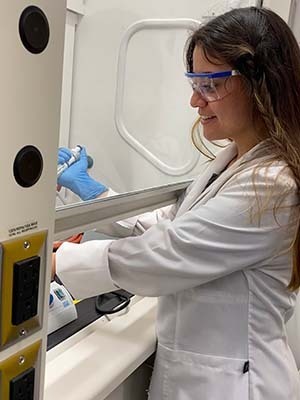
Nanotechnology has become one of the most important sciences for innovation in material sciences nowadays and mostly in the medicine field. In this research is reported a Gold Nanoparticles with Janus behavior (Janus AuNPs) as a novel method to do drug delivery to cancer cells. The novelty in this Janus nanoparticle is the immiscible nature of two thiol-derived polymers on the gold surface, Polyethylene glycol (PEG) and Polystyrene (PS), which can self-assemble on the gold in a tunable fashion by varying the size, polymer ratio and temperature, among other experimental parameters [1] but at the same time, one of the two polymers used (PEG) acts as a primer and therefore a partial SiO2 coating is added to the gold nanoparticle to create a Janus structure [2]. This means that we could improve the biocompatibility and stability in biological environments, such as the human body. Therefore, Janus AuNPs in the future seems to be a promising noble nanoparticle that improve the drug delivery in cancer cells while incorporating multiple modalities.
Brenda Cruz Gonzalez • Universidad de las Américas Puebla
Professor Prakash Nallathamby • Aerospace & Mechanical Engineering
Professor Paul Helquist • Chemistry & Biochemistry
Maximizing the piezoelectric response from inorganic-organic composite electrospun nanofibers (Brian Beas)
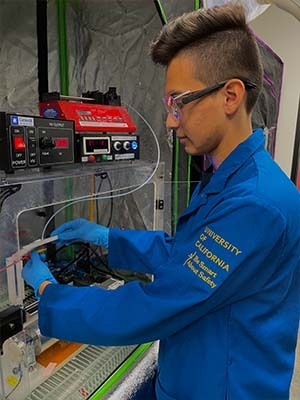
To reach environmental sustainability and address climate changes, it is critical to develop new renewable energy sources. Piezoelectric materials have been effective at improving energy harvesting and storage in nanogenerators as they couple mechanical stress and electrical polarization processes. By incorporating strong, but brittle, inorganic piezoelectric materials in flexible, weak piezoelectric polymers, we hope to maximize the synergistic piezoelectric response for nanogenerators.
Brian Beas • University of Notre Dame
Professor Nosang Myung • Chemical & Biomolecular Engineering
Molecular and process design framework for the separation, recycling, and reuse of hydrofluorocarbon mixtures (Tipton Lichtenstein)
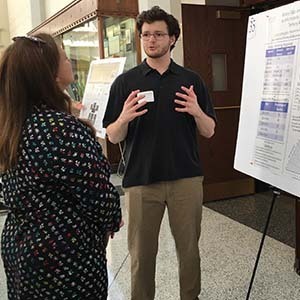
An increasing amount of attention has been placed on HFC refrigerants due to their ozone depletion potentials and global warming potentials. Addressing this concern, we seek to create a framework to optimize HFC separation processes and develop methods for screening ILs for HFC separations allowing recycling and reuse of HFCs. We utilize experimental data and molecular simulations to model and optimize a process system for the separation of R-410A at scale while remaining economically viable.
Tipton Lichtenstein • University of Florida
Professor Alexander Dowling • Chemical & Biomolecular Engineering
Professor Ed Maginn • Chemical & Biomolecular Engineering
Nanoparticle theranostic agents for breast cancers (Alexandra Alvarado)
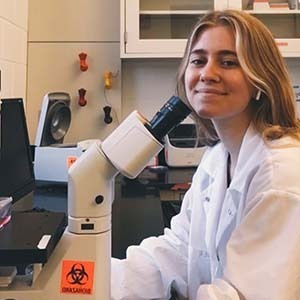
The application of gold nanoparticles in breast cancer treatment can be used as a tool for early detection of breast cancer and as a therapeutic treatment by inhibiting mitogenesis. Bisphosphonate pegylated gold nanoparticles (BP-Peg-AuNPs) have a high binding affinity to hydroxyapatite microcalcifications commonly found in breast cancer because of their high retention effect, permeability, and affinity for calcium. My project focused on measuring the cytotoxicity of spherical BP-Peg-AuNPs within the body through in vitro testing using an MTT assay on HS578T cells, which measures cell metabolic activity.
Alexandra Alvarado • University of Notre Dame
Professor Ryan Roeder • Aerospace & Mechanical Engineering
Professor Laurie Littlepage • Chemistry & Biochemistry
Optimizing PLGA-derived gel for steady release of phage-mimicking antimicrobial nanoparticles (Argerie Guevara)
This project aims to design a PhANPs formulation that will release the PhANPs from a resorbable gel at a steady rate for prolonged antimicrobial action. By incorporating the PhANPs into a PLGA derived gel, we can determine the kinetics of release of gel encapsulated PhANPs for a better way to stop the growth of harmful bacteria. Through published literature, PLGA nanoparticles were synthesized and incorporated with fluorescein to determine the dissolution rate of PLGA.
Argerie Guevara • University of Notre Dame
Professor Prakash Nallathamby • Aerospace & Mechanical Engineering
Professor Paul Helquist • Chemistry & Biochemistry
Plasma-injected solvated electrons in various configurations (Elena Parial)
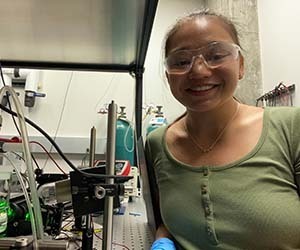
Total internal reflection absorption spectroscopy is one way to observe solvated electrons produced in plasma-liquid systems. Here it will be used to characterize plasmas in nonaqueous solvents and in positive polarity configurations. In nonaqueous solvents, we expect to see different reaction dynamics, in particular, mitigating second order recombination with water. In positive polarity we hope to directly observe solvated electrons produced by incoming ions.
Elena Parial • Purdue University
Professor David Go • Aerospace & Mechanical Engineering
Water remediation via electrospun MIL-101@ZIF-8-embedded nanofibers as copper filters (Nicholas Lowe)
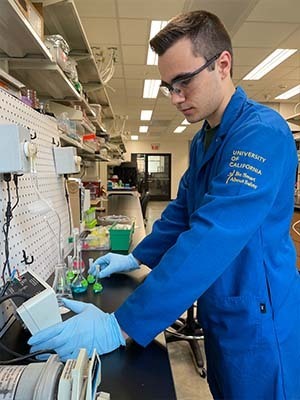
Point-of-use water filters via electrospun nanofibers can enable safe drinking water practices. In this work, MIL-101@ZIF-8, a highly efficient copper adsorbent with a core-shell MOF@MOF design [4], was optimally electrospun into functional nanofibers. MIL-101@ZIF-8 was critical in retaining zinc and thus the structure of ZIF-8, which would keep water pure and create potential for filter reuse. The asspun nanofibers were tested for copper removal efficiency with the goal of meeting standards set by the EPA.
Nicholas Lowe • Vanderbilt University
Professor Nosang Myung • Chemical & Biomolecular Engineering
Effects of acidity and salinity on polymer drug-delivery complexes (Sarah Bluhm)
The effect of acidity on the partition coefficients of molecules into coacervates remains an open area of inquiry. This summer project succeeded in setting up a preliminary system that will be appropriate for testing the uptake of a variety of molecules into a coacervate phase consisting of 10-mer polylysine and polyglutamic acid peptides.
Sarah Bluhm • Northeastern University
Professor Jonathan Whitmer • Chemical and Biomolecular Engineering
Integration of molecular and process design framework for the separation, recycling, and reuse of hydrofluorocarbon mixtures (Erick Mendez Rios)
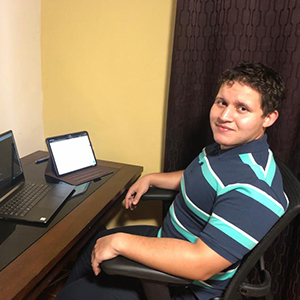
The goal of this project is to develop tools and processes that enable the separation of high and low global warming potential HFCs. To achieve this, we conducted molecular simulations to compute the density of four different ionic liquids and compared them to experimental data. Next, we optimized solubility simulations to allow us to simulate the solubility of ionic liquids mixed with HFCs. Finally, we are attempting to predict the vapor-liquid-equilibrium curve of an R-125/R-32 azeotropic mixture.
Erick Mendez Rios • University of Puerto Rico at Mayaguez
Professor Edward Maginn • Chemical & Biomolecular Engineering
Professor Alexander Dowling • Chemical & Biomolecular Engineering
Winter Session: Coupled cellular polarization of vascular morphogenesis patterns (Erin Neu)
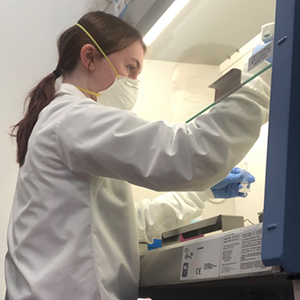
A fundamental question in developmental biology concerns how groups of interacting molecules and cells give rise to patterned 3D tissues with special form and function. In particular, we are interested in the process by which endothelial colony-forming cells (ECFCs) have different vascular morphogenesis patterns. The patterns of different ECFC types can be influenced by exosomes transferred between normal and disease phenotypes (e.g., preeclampsia). The impact of vascular morphogenesis by exosomes illustrates preeclampsia’s potential causes and impact on angiogenesis and a potential treatment that reverts preeclampsia tube formation to original, typical tube formation.
Erin Neu • Chemical and Biomolecular Engineering
Donny Hanjaya-Putra • Aerospace & Mechanical Engineering
Winter Session: Frequency domain diffuse optical spectroscopy (FD-DOS) on a chip (Alex Beck)

In this project we investigated the use of an application specific integrated circuit (ASIC) for frequency domain diffuse optical spectroscopy (fd-DOS) to reduce the size, power consumption, and cost of noninvasive quantitative tissue optical characterization. We conducted experiments that simulate signals received from diffuse optical imaging of breast tissue in order for the device to measure changes in amplitude and phase needed for fd-DOS imaging.
Alex Beck • Electrical Engineering
Thomas O'Sullivan • Electrical Engineering
Winter Session: Self-charging battery, printable battery, and polysiloxane-based single-ion conducting gel electrolyte (Josiah Viitala)
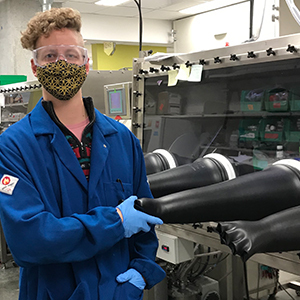
I worked on three different projects with the same overall goal as stated above. All focused on producing a working electrolyte for advanced lithium-ion rechargeable batteries while trying to incorporate a piezoelectric material into the process. Experiments done were in effort to produce an electrolyte with high conductivity and ion flow with crosslinked polymers.
Josiah Viitala • Chemical and Biomolecular Engineering
Jennifer Schaefer • Chemical and Biomolecular Engineering
Winter Session: Superparamagnetic nanobeads and nanomembrane for virus isolation and detection (Grace Gasper)
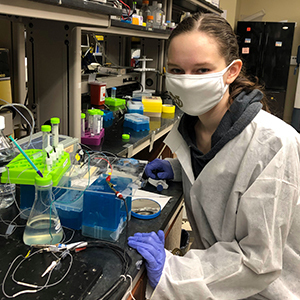
In the midst of an unprecedented global pandemic, there have been numerous issues with improving the accessibility, scalability, and accuracy of COVID-19 screening tests. One large issue is the high percentage of false negatives due to a low abundance of virus particles, analyte lost during dilution/extraction, or noise. The purpose of the project is to use the high-throughput and high-yield Asymmetric Nanopore Membrane (ANM) filtration technology for isolation and enrichment of virus particles in order to provide a rapid, cheap, and accurate POC test.
Grace Gasper • Chemical and Biomolecular Engineering
Hsueh-Chia Chang • Chemical and Biomolecular Engineering
Computational modelling of co-evolutionary genetics in ecosystems (Kiran Jain)
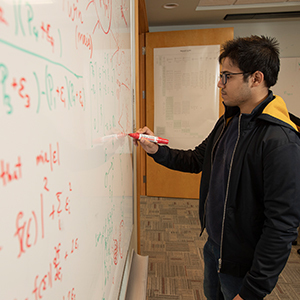
Beetles are present in a habitat. Each beetle competes with the other members of the beetle species for resources available in the habitat (like food) to survive and produce offspring. However, not all beetles are the same and some are “fitter” than others, implying that they are more likely to defeat other beetles in a competition for a resource. Our research has aimed at creating a virtual ecosystem which mimics these real-world interactions amongst the species members to help us find answers to the evolutionary questions like - How does the average beetle size change over time? Who eventually wins this race of evolution? What happens when mites come into picture and interact with the beetles in the ecosystem? Inclusion of mites into the system makes it even more interesting, since the interactions between the different species varies for every individual. Hence, while there might be positive mutualistic relationships between beetles of some size and mites, there might be parasitic relationship between mites and beetles of another size. This research is, hence, also interested in knowing the relationship between size and the mutual interactions between the two species.
Kiran Jain • Indian Institute of Technology, Delhi
Professor Dervis Can Vural • Physics
Controlling lymphatic tube formation using synthetic hydrogels (Adriana Archilla Fraticelli)
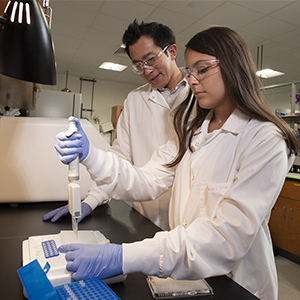
We utilize hyaluronic acid hydrogels to investigate mechanical and biomechanical cues that regulate lymphangiogenesis. Using different substrate stiffnesses as mechanical stimuli and a supplemental growth factor as biochemical stimuli, lymphatic endothelial cell growth and migration is promoted, causing lymphatic vessel formation. Real-Time PCR analysis suggests several genes, which are associated with matrix remodeling and cell migration, are directly linked to these findings and may be the underlying mechanism of improved lymphatic vessel development.
Adriana Archilla Fraticelli • Syracuse University
Professor Donny Hanjaya-Putra • Aerospace & Mechanical Engineering
Development of a flowing thin-film plasma-liquid system (Alfred Chang)
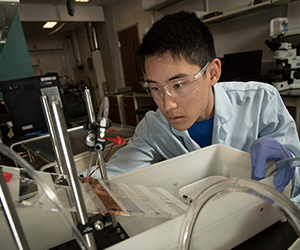
Recent experiments from the Go Research Group using a batch reactor plasma electrolytic cell observed a significantly lower faradaic efficiency, the ratio of product molecules to incident electrons, than that expected from theoretical predictions. This reduced value is consistent with the intended reaction being limited by reactant depletion at the plasma-liquid interface. To mitigate this effect, the aim of this work is to construct a microfluidic flowing thin-film plasma system to examine the effects liquid film thickness, on the order of the size of the depletion region, has on faradaic efficiency, using flow to refresh processed liquid and inhibit evaporation.
Alfred Chang • Carnegie Mellon University
Professor David Go • Aerospace and Mechanical Engineering
Development of a pyroelectric-driven plasma generation testing rig (Se Hwan Jeon)
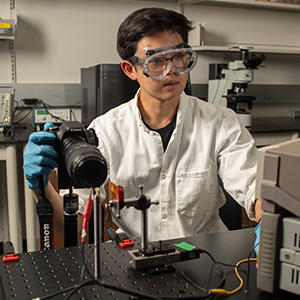
In this study, a lithium tantalate pyroelectric crystal was thermally cycled with a resistance heater to produce an atmospheric pressure gas discharge. A copper plate parallel to the crystal and a picoammeter were used to determine the current of the plasma. By coating the crystal with silver paint, “triple points” were created that significantly enhanced the current of the discharge. Time-integrated visualization showed the formation of surface discharges on both crystals during the thermal cycling.
Se Hwan Jeon • University of Notre Dame
Professor David B. Go • Aerospace and Mechanical Engineering
Professor Seong-Kyun Im • Aerospace and Mechanical Engineering
Dynamic peptide-based nanomaterials for enzyme targeted drug delivery (Katherine La Costa)
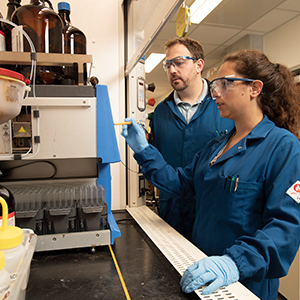
Drug delivery systems control the spatiotemporal characteristics of drugs in the body, increasing drug efficacy while decreasing adverse effects on healthy cells. This project focuses on the synthesis and characterization of anti-inflammatory drug corticosteroid Dexamethasone conjugated via a hydrolysable hydrazone linker to short amphiphilic peptides, designed to form nanofibers by supramolecular self- assembly and provide drug release over time by the slow hydrolysis of the linker. Future work includes modifications to the peptide sequence to incorporate enzyme sensitivity to target inflammation.
Katherine La Costa • University of Notre Dame
Professor Matthew Webber • Chemical & Biomolecular Engineering
Energy recovery for low energy computation (Joe Carthy)
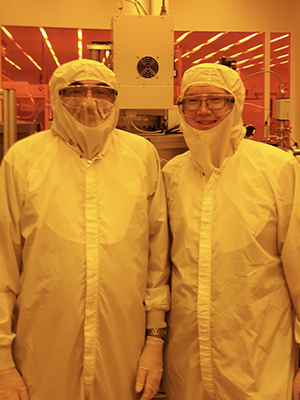
The project I worked on over the summer involved research into adiabatic circuits. Initially, it involved developing a method for simulating adiabatic circuits, that had been designed in Cadence, using SystemVerilog. Later stages involved designing adiabatic circuits in Cadence that contained temperature measurement devices, with the purpose of detecting the energy dissipated by these circuits.
Joe Carthy • University College Dublin, Ireland
Professor Greg Snider • Electrical Engineering
Fabrication of ductile yet tough polymer nanocomposites (Stephen Koch)
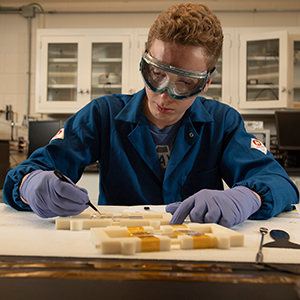
Polyethylene (PE) and polydimethylsiloxane (PDMS) are two polymers with very different mechanical properties. A composite of these two materials could incorporate desirable properties of both, creating a material that is both flexible but also has a high ultimate tensile strength. Such a material would be useful to create wearable electronics, especially when electrical components are integrated into the material through aerosol jet printing.
Stephen Koch • University of Notre Dame
Professor Tengfei Luo • Aerospace & Mechanical Engineering
Fabrication of gold nanoplates using substrate-immobilized seeds lined with planar defects via a directed-shock wave (Zijuan Liang)
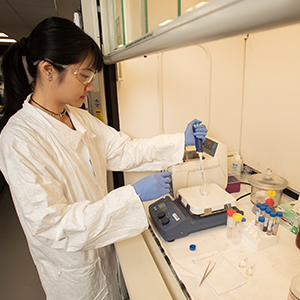
We present a novel method for the solution-based synthesis of substrate-immobilized hexagonal Au nanoplates using the block copolymer Brij® 700 and HAuCl4. The growth mode has been optimized with respect to the copolymer and Au salt concentrations, pH, temperature, and growth time. Planar defects are needed for nanoplates growth, but the high crystallinity of Au seeds limits the number of defects formed. We, therefore, prototyped a device to induce planar defects in single-crystal Au by a manually generated shockwave in water. Preliminary spectroscopic data and simulations show that the shockwaves altered the Au morphology.
Zijuan Liang • University of Notre Dame
Professor Svetlana Neretina • Aerospace & Mechanical Engineering
Professr Karel Matous • Aerospace & Mechanical Engineering
Generation of plasma activated water (PAW) using mechanical actuation of piezoelectric crystals (Federico Hita Martinez)
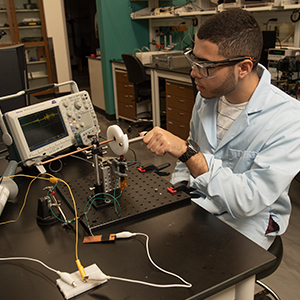
A hand-cranked system for piezoelectric actuation was developed to observe plasma-surface interactions with water. The pH of water was measured to decrease drastically from 7 to approximately 2 over an activation time of 5 minutes. Nitrate concentrations were measured to be approximately 1.5-2.5 mg/L. These values were promising when compared to concentrations recorded using other forms of plasma generation. The findings from this study have strong implications in the field of plasma agriculture due to the potential of plasma activated water for enhancing plant growth.
Federico Hita Martínez • University of Notre Dame
Professor David Go • Aerospace & Mechanical Engineering
Professor Seong-Kyun Im • Aerospace & Mechanical Engineering
Intermetallic hydrogen separation membranes: towards unprecedented permeability and stability (Austin Booth)
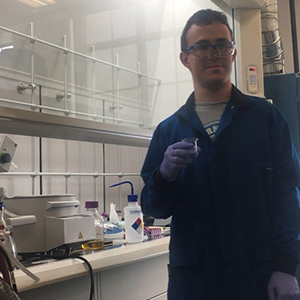
Our goal has been to synthesize pure, defect-free palladium membranes using electroless plating and to test the effects of different preparation methods on membrane composition. Porous stainless steel disks were pretreated, coated with intermediate ceramic layers, then plated with Pd using both EDTA-free and EDTA baths. The EDTA-free bath was found to produce pure, defect-free membranes but was less stable at room temperature, although stability was improved by changing temperature and solution composition.
Austin Booth • University of Notre Dame
Professor Casey O'Brien • Chemical & Biomolecular Engineering
Magneto-silica nanoparticles (MagSiNs) for combinatorial chemotherapeutics and gene delivery against metastatic cancers (Stephanie Wallace)
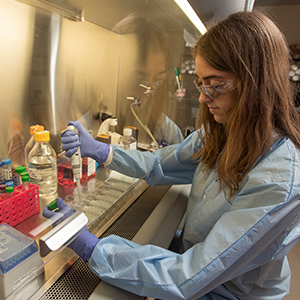
This project seeks to combine the use of magneto-silica nanoparticles (MagSiNs) conjugated liposomes with a fluorescent payload to mimic selective chemotherapeutics delivery to metastatic cancer cells. Liposomes synthesized with a fluorescent cell-impermeant payload were conjugated with MagSiNs to create a label-free magnetic nanocarrier system. In vitro studies were performed to look at the difference in the efficiency and selectivity of payload delivery in different cancer cells with and without a magnetic force applied at the cell membrane.
Stephanie Wallace • University of Notre Dame
Professor Prakash Nallathamby • Aerospace & Mechanical Engineering
Professor Paul Helquist • Chemistry & Biochemistry
Modular assembly of metamaterials using light gradient (Alex Volk)
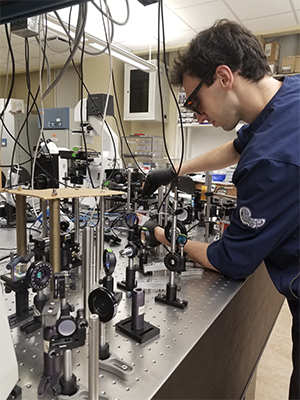
The use of light gradient forces to manipulate and organize nanometer-scale matter is a radically new strategy for manufacturing nanosystems. A laser can be split into a 2D array for trapping particles, and by reflecting the beam off a mirror, a standing wave optical trap forms in the third dimension along which particles can stack up, creating a full 3D lattice. In this way thousands of nanoparticles can be manipulated into a complex heterogeneous voxel to form nanosystems of any size, shape and constituency.
Alex Volk • University of Notre Dame
Professor Gregory Timp • Electrical Engineering & Biological Sciences
Phononic nanoparticles for low-loss, tunable nanophotonics in the mid- and far- IR (Caroline Howell)
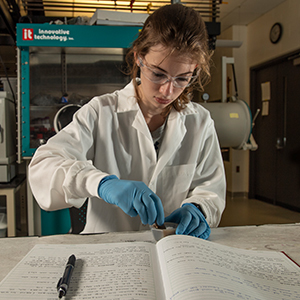
Phononic nanoparticles are optical materials that resonate with and absorb light in the mid- and farinfrared region of the electromagnetic spectrum. The influence of particle size and morphology on a material’s optical properties in this region has not yet been investigated. Commercially-available zinc oxide nanoparticles were used to prepare samples for optical characterization. Later, zinc oxide was synthesized by a variety of methods with the goal of creating monodispersed nanoparticles with tunable physical properties.
Caroline Howell • University of Notre Dame
Professor Ryan Roeder • Aerospace & Mechanical Engineering
Professor Anthony Hoffman • Electrical Engineering
Polymer membranes with tunable microporosity for gas separations (Evan Ferguson)
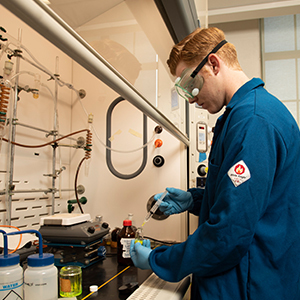
The market for membrane-based technology for gas separations is expanding rapidly as membranes achieve higher levels of permeability and selectivity. This project focuses on the design and production of pentiptycene-based ladder polymers, in the hopes to push the known limit for permeability and selectivity. By increasing purity and optimizing polymerization defect free membranes are produced, while changing the functionality of substituent groups creates more selective performance.
Evan Ferguson • Bethel University
Professor Ruilan Guo • Chemical & Biomolecular Engineering
Profiling homomorphic encryption in secure data mining (Cian Levy)
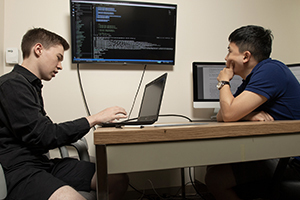
Homomorphic encryption has many applications in data mining using private data sets. Current implementations of homomorphic encryption schemes remain slower than insecure computation by factors of several thousand. The aim of this project is to access the performance of popular homomorphic encryption libraries by applying them to evaluate circuits, and determine how their parameters influence performance in practice.
Cian Levy • Trinity College Dublin, Ireland
Professor Taeho Jung • Computer Science & Engineering
Solvent-in-Salt Electrolytes for next generation rechargeable lithium batteries (Ebrima Komma)
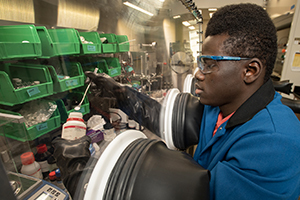
Organic liquid electrolytes are a key component in commercial lithium ion batteries as they permit conduction of lithium ions between the cathode and anode. Electrolytes that have high ionic conductivity are ideal as they allow the lithium-ion battery to charge/discharge efficiently. However, these electrolytes currently raise safety concerns as they are easily flammable and unstable towards high voltage and temperature. We introduce a new set of Solvent in Salt electrolyte that improves ionic conductivity and solvent stability, by utilizing Li+ containing liquid crystals as the salt.
Ebrima Komma • University of Mississippi
Professor Jennifer Schaefer • Chemical & Biomolecular Engineering
Spectroscopic photoresponse system for measurement of semiconductor heterostructure band-offsets (Muireann de h-Óra)
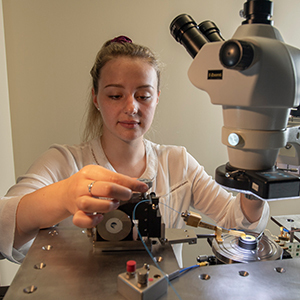
Polarizable materials including ionic polymers and ferroelectrics are used as dielectrics in capacitors, and gate oxides in transistors for analog memory for machine learning. In these applications, the barrier heights presented to electrons in metal-oxide-semiconductor (MOS) structures are key design parameters. The aim is to configure a measurement system that controls the energy of incident photons on a semiconductor device and records a photoresponse as a function of applied bias and photon energy, providing a direct measurement of the electronic barrier heights in such heterostructures.
Muireann de h-Óra • University College Cork, Ireland
Professor Alan Seabaugh, Electrical Engineering
Spin-assisted fabrication of biomimetic membranes with artificial water channels for next generation water purification (Thomas Kasl)
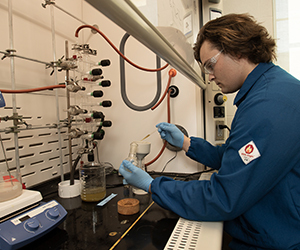
Naturally-occurring aquaporin protein channels exhibit a combination of high permeability and selectivity that state-of-the-art desalination membranes do not possess. Fragile aquaporins are not feasibly integrated into a functional and scalable reverse osmosis (RO) membrane. Bio-inspired pillar[5]arene artificial water channels have been synthesized as integrable aquaporin alternatives, and via a “click” synthesis approach can be designed with finely-tuned pore characteristics. Automated spin coating, inherently scalable and repeatable, allows for a simple and straightforward incorporation of these channels into biomimetic membranes.
Thomas Kasl • University of Notre Dame
Professor William Phillip • Chemical & Biomolecular Engineering
Professor Jennifer Schaefer • Chemical & Biomolecular Engineering
Synthesis and measurement of charge switching in mixed valence molecules (Grant Barthelmes)
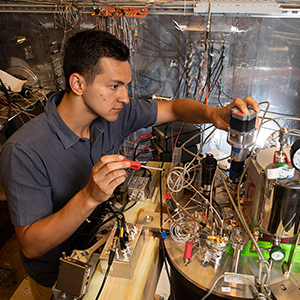
As the longevity of Moore’s law is in question and limits on heat dissipation force design compromises, new options for computing must be explored. One promising model is molecular-based computing, in which one of the first steps is to measure the movement of a single localized electron within a molecule. To do this, a highly sensitive electrometer, such as a modified single electron transistor, must be designed and tested. To facilitate the development of these electrometers, testing and fabrication systems must be optimized. First, testing time is cut down by converting a manual controlled thermal switch into a computer controlled system through the use of a stepper motor, sensors, microcontroller, and writing a program to interface with this system. Secondly, fabrication time is lessened by developing precise lithography, development, and wet etch steps used to make consistent undercuts needed in the Dolan Bridge Process used to make these electrometers.
Grant Barthelmes • University of Notre Dame
Professor Gregory Snider • Electrical Engineering
Professor Emily Tsui • Chemistry & Biochemistry
Determining the Faradaic efficiency of plasma-liquid systems (Rebecca Radomsky)
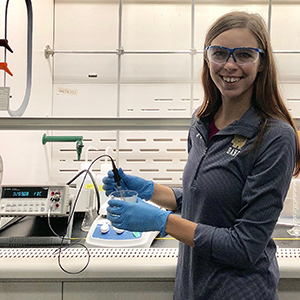
Abstract: Using a plasma cathode, our specific focus has been on understanding the inherent limitations to the Faradaic efficiency in a plasma electrolytic cell using two model systems: the classic ferri/ferrocyanide redox couple as well as the dissociative electron attachment to chloroacetate. Using optical absorption spectroscopy and an ion selective electrode, the respective concentrations of ferricyanide and chloride were measured, and calculated Faradaic efficiencies were compared to theoretical predictions.
Rebecca Radomsky • University of Notre Dame
Professor David Go • Aerospace & Mechanical Engineering
Development of microimplants for deep tissue optical sensing (Stephen Bauer & Mark Etzelmueller)
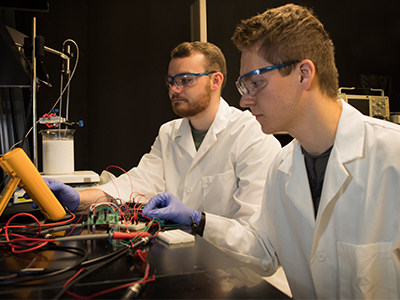
Abstract: We are developing a micro-implantable monitoring system that provides real-time feedback to cancer therapy. The device proposed here will be capable of monitoring deep tissue (> 1 cm) whilst being small enough to fit into a needle to be injected directly into the tumor. The device uses light to assess the molecular properties of the tumor microenvironment, utilizing one or more laser diodes, a photodiode, a radio-frequency power-harvesting circuit, and a Bluetooth microcontroller to do so.
Stephen Bauer • Purdue University
Mark Etzelmueller • University of Notre Dame
Professor Thomas O'Sullivan • Electrical Engineering
Elucidating fundamental processing property relationships for chemically patterned membranes (Nishtha Gupta)

Abstract: The Phillip lab has developed chemically-patterned membranes like charge mosaic membranes which have patterns of positively and negatively charged domains that traverses the membrane thickness. The membrane with these oppositely charge-functionalized domains are able to separate charged species from neutral molecules of comparable sizes. Pressure driven transport experiments performed using these membranes showed that the concentration of ions was enhanced in the permeate as compared to the retentate. In order to improve the selectivity and increase the density of specific ion interactions on the pore walls of a nanoporous copolymer membrane, the pore wall chemistry was modified. The successful functionalization of pore chemistry using polyethyleneimine and 4-imidazolecarboxylic acid was characterized using FTIR and single solute rejection experiments.
Nishtha Gupta • Indian Institute of Technology, Delhi
Professor William Phillip • Chemical & Biomolecular Engineering
Functional chemical sensor and coating for fluid dynamic applications (William Gothard)
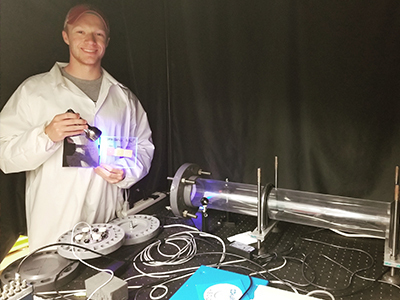
Abstract: The possibility of using pressure sensitive paint (PSP) as a stand-alone measurement device in unsteady flow fields is being realized with the development of faster and more sensitive PSP. Unsteady phenomena occur quickly, often on the order of 10 kHz. To effectively apply PSP to such unsteady flow conditions, the response characteristics of the PSP must be understood by exposing PSP to a known controlled pressure field of acoustic waves and examining the response variation from traditional pressure measurement devices.
William Gothard • North Carolina State University
Professor Hirotaka Sakaue • Aerospace & Mechanical Engineering
Image processing and data analysis in transmission electron microscopy (Gavin Inglis)
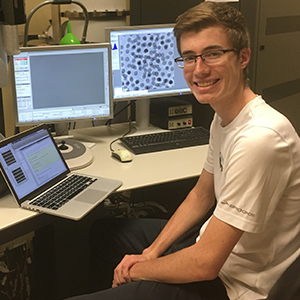
Abstract: Transmission electron microscopy is one of most advanced metrologies in materials science, and the fast and accurate analysis of TEM data is a key for success in delivery of novel results. This research focuses on developing scripts written in MATLAB to process images and analytical data to get the most accurate results in TEM using periodicity vectors and an intensity averaging algorithm.
Gavin Inglis • University of Notre Dame
Professor Sergei Rouvimov • Electrical Engineering
Improving drug efficacy through supramolecular affinity (Erin O'Brien)

Abstract: The use of reversible, non-covalent supramolecular interactions affords routes to materials with tunable function for a variety of applications.1 Certain host macrocycles afford high affinity binding for complementary small molecule guest motifs.2 One such interaction with the N-terminal phenylalanine on insulin was shown to promote enhanced stability, solubility, and efficacy of the protein when a macrocycle was covalently fused to a hydrophilic polymer.3 To determine the utility of this approach as a platform excipient for the stabilization of many different protein drugs, we have worked to devise assays for real-time monitoring of protein aggregation. Leveraging the change in optical density of a protein upon aggregation, we replicated stressed storage conditions and determined the stability of insulin and related proteins under these conditions. Additionally, we developed a novel synthetic route to modify macrocycles, for exploration of its use in conjugation chemistry. These modified macrocycles will expand the use of supramolecular chemistry to facilitate new drug delivery or drug capture technologies.
1 Webber, M. & Langer, R. (2017). Drug delivery by supramolecular design. Chemical Society Reviews, 46(21), 6600-6620.
2 Webber, M. & Langer, R. (2017). Drug delivery by supramolecular design. Chemical Society Reviews, 46(21), 6600-6620.
3 Webber, M., et al. (2016). Supramolecular PEGylation of Biopharmaceuticals. PNAS 113(50), 14189–14194.
Erin O'Brien • University of Notre Dame
Professor Matthew Webber • Chemical & Biomolecular Engineering
Investigation of the sorption behavior of organic acids onto catalytic- and food-grade titanium dioxide nanoparticles (Angela Abarca Perez)
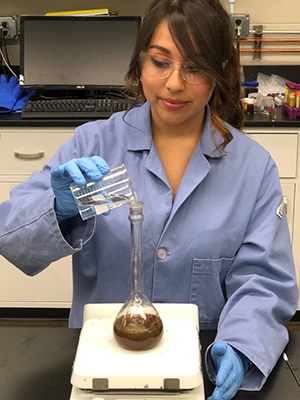
Abstract: In this study the adsorption of DOM- analogue organic acids (mono-carboxylic acids, di-carboxylic acids, tri-carboxylic acids, and phenols) onto the surface of TiO2 nanoparticles (commercial Evonik P90, food-grade E171 and hydrothermally synthesized nanoparticles) with acidic pH and constant ionic strength, is being assessed in order to predict its behavior in natural environments where complex molecules such as humic acid are present.
Angela Abarca Perez • Universidad Popular Autónoma del Estado de Puebla (UPAEP)
Professor Kyle Doudrick • Civil & Environmental Engineering and Earth Sciences
Magneto-electric silica nanoparticles (MagSiNs) for combinatorial chemotherapeutics against metastatic cancers (Margo Waters)
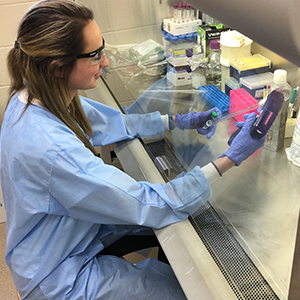
Abstract: This project sought to identify whether chemotherapeutics could be combined and conjugated to magneto-electric silica nanoparticles (MagSiNs) for a more effective and targeted delivery to metastatic cancers. MagSiNs are a drug carrier system, so the chemotherapeutics can be magnetically guided directly to the cancer cells using permanent magnets. The drugs can then be triggered for instantaneous release when exposed to an external electromagnetic field. We compared the effects of this targeted drug delivery to normal free drug addition, as well as the biocompatibility to normal tissue.
Margo Waters • University of Notre Dame
Professor Paul Helquist • Chemistry & Biochemistry
Professor Prakash Nallathamby • Aerospace & Mechanical Engineering
Polymer electrolytes for advanced rechargeable batteries (Jacob Thilman)
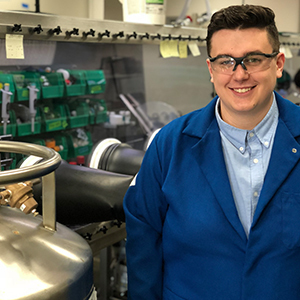
Abstract: Current magnesium-sulfur batteries are not currently commercially viable due to their short lifespan from the polysulfide shuttle effect. One approach to preventing the polysulfide shuttle is coating the cathode with a functional polymer. In this project, a variety of monomers and film compositions are characterized to discover films which are conductive, permeable to the electrolyte, but reject polysulfides.
Jacob Thilman • University of Notre Dame
Professor Jennifer Schaefer • Chemical & Biomolecular Engineering
Quantitative assessment of the role of dissolved oxygen in the catalytic reduction of 4-nitrophenol by metal nanoparticles (Yuko Inoue)
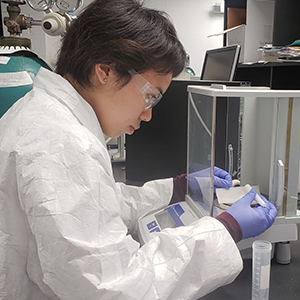
Abstract: The reduction of 4-nitrophenol to 4-aminophenol by borohydride is a commonly used model reaction for characterizing the efficacy of catalysts. Although this reaction has been intensely studied, the cause of induction time, an initial period where no reaction seemingly occurs, has only recently been imputed to dissolved oxygen. The performed study characterizes the effect of catalyst on induction time. There is a weak correlation between induction time and borohydride concentration and a strong correlation between induction time and amount of catalyst.
Yuko Inoue • University of Notre Dame
Professor Svetlana Neretina • Aerospace & Mechanical Engineering
Stretchable polymer composite film with extreme ductility and toughness (Jacob Galden)
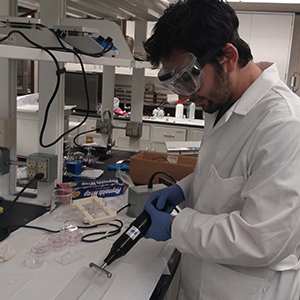
Abstract: Composite films were prepared to have superior strength and ductility by laminating PE fibers between PDMS films. The process includes stretching the PDMS while it is bonding and then relaxing it afterwards in order to produce wrinkles that preserve the PDMS’s ductility in the final composite. The composite displays two distinct behaviors depending on its strain ratio: low strain behaves like PDMS but higher strains behave similar to PE.
Jacob Galden • University of Notre Dame
Professor Tengfei Luo • Aerospace & Mechanical Engineering
Stretchable polymer composite film with extreme ductility and toughness (Paula Murphy)
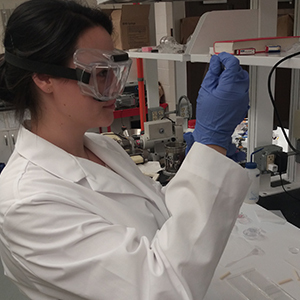
Abstract: The purpose of this project was to successfully create a highly ductile polymer composite with great tensile strength and toughness, which would be capable of undergoing significant strain without fracture failure. The polymer composite consisted of a matrix of polydimethylsiloxane (PDMS) and reinforcing ribbons of molecularly aligned polyethylene. The results proved successful, whereby the ultimate tensile strength of the final polymer composite was approximately four times that of pure PDMS while maintaining its ductility.
Paula Murphy • Trinity College Dublin
Professor Tengfei Luo • Aerospace & Mechanical Engineering
Synthesis and performance testing of pentiptycene-based polymeric membranes for mixed gas separation (Santiago Calderon Novoa)
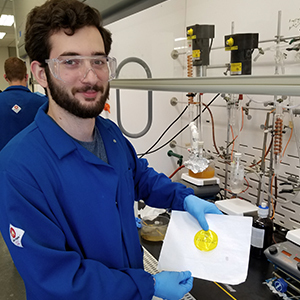
Abstract: Microporous polymeric gas separation membranes are sought out for their ability to sieve gases based on their molecular size and interactions with the membrane itself. This project focuses on the bottom-up fabrication of polymers of intrinsic microporosity (PIMs), which contain pentiptycene-based monomeric units with rigid, highly contorted, and robust chemical structures. This allows the polymer to have a tight micropore size distribution, which can yield high permeability and selectivity for challenging gas separation applications.
Santiago Calderon Novoa • University of Notre Dame
Professor Ruilan Guo • Chemical & Biomolecular Engineering
Synthesis and polarized optical microscopy of lithium conducting liquid crystalline electrolytes (Matthew Winkler)

Matthew Winkler • University of Notre Dame
Professor Jennifer Schaefer • Chemical & Biomolecular Engineering
Synthesis of zinc oxide and titanium dioxide nanoparticles for phononic resonance in the mid- and far-infrared (Evan Gies)
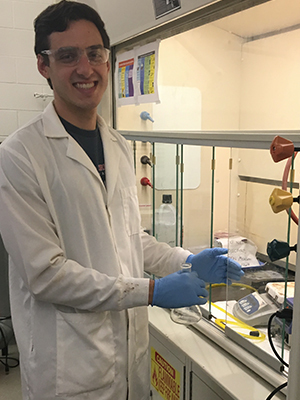
Abstract: Phononic nanoparticles (PhNPs) are a new class of materials that interact with light in the mid- and far-infrared region of the electromagnetic spectrum. The optical properties of nanoparticles in this region have not yet been investigated. Zinc oxide and titanium dioxide were synthesized by a variety of methods with the goal of preparing spherical monodispersed nanoparticles suitable for optical characterization.
Evan Gies • University of Notre Dame
Professor Ryan Roeder • Aerospace & Mechanical Engineering
Professor Anthony Hoffman • Electrical Engineering
Analyis of porosity, mineralization, and damage as contributors to fracture risk (Benjamin MacCurtain)
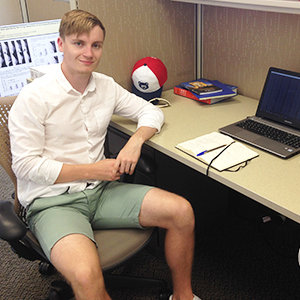
Abstract: This study utilized a combination of experimental and computational methods to develop a non-linear finite element model capable of predicting human cortical bone fractures based on the levels of fatigue microdamage, porosity and mineralization. Based on preliminary tests the non-linear model can predict a fracture during simulation based upon the above-mentioned bone characteristics with better than random probability. Additional steps are being taken to ensure the non-linear finite element model and the experimental model are demonstrating bone fracture initiation points in the same region.
Benjamin MacCurtain • Dublin City University (Naughton REU)
Prof. Glen Niebur • Aerospace & Mechanical Engineering
Prof. Ryan Roeder • Aerospace & Mechanical Engineering
Analysis and experimental demonstration of thermal diodes with phase-change and phase-invariant material junctions (Raul Lema Galindo)
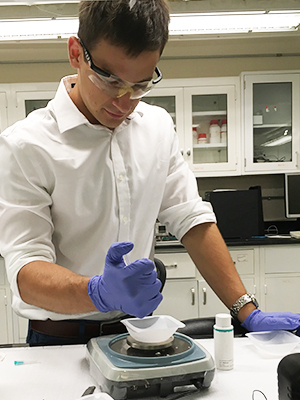
Abstract: My main task during research was to test a thermal diode composed of a junction of two materials, one of which was phase-invariant, and the other underwent phase transition at a known temperature. Using a thermal conductivity testing instrument, it was possible to demonstrate that an appreciable thermal rectification could be obtained when comparing the sample thermal conductivity under forward and reverse temperature bias, where the phase change material was present in one of two phases depending on the direction of heat flow, i.e. which side of the sample (phase-invariant or phase-change material side) was exposed to higher temperature.
Raul Lema Galindo • University of Notre Dame
Prof. Tengfei Luo • Aerospace & Mechanical Engineering
Chemical sensor for fluid dynamic and environmental applications (Alfredo Duarte)
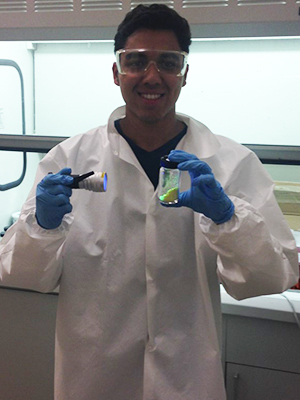
Abstract: Pressure sensitive paint consists of two luminescent dyes: a reference probe and a pressure sensitive probe, solvent, polymer, and porous material. In this study, I elaborated the individual luminescent powders of the PSP by varying parameters such as the concentration of luminescent dye and porous material, solvent and method of drying. The powders were then characterized by its brightness and uniformity.
Alfredo Duarte • University of Notre Dame
Prof. Hirotaka Sakaue • Aerospace & Mechanical Engineering
Custom‐built reaction chambers and in situ monitoring tools (Kyle Kotesky)
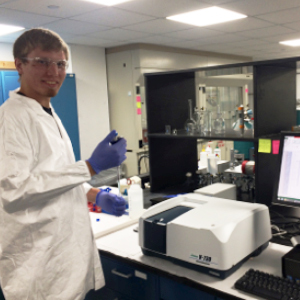
Abstract
Catalyst Leach Project
This project consisted of experimenting on different metal catalysts to see if they leach. Thin metal films were used. The atoms of the metal detach from catalyst causing the atoms to form nanoparticles that become catalytic. This causes the reaction to continue even when the initial catalysts is removed. A 3-D drawing was needed to demonstrate how the samples were put in and taken out of cuvette. A spectrometer is used to monitor the solutions reacting time.
Sample Holder Design Project
A design to hold a sample in a spectrometer was needed to apply voltage to the sample. This would allow the spectrometer to monitor the sample that has current travelling through it. This had to be small enough to fit into the spectrometer and hold a 7 cm x 7 cm x 0.07 cm sample.
Stamping Removal Design Project
A new stamping design for nanoimprint lithography was needed to have a better way to remove the sample from the stamp. Once the sample is heated up and stamped, the removal process took too much time and did not consistently work. The new design must hold the sample and adjust to the sample size. The holder should remove the sample from the stamp when the holder moves up away from stamp.
Kyle Kotesky • Purdue Polytechnic
Prof. Svetlana Neretina • Aerospace & Mechanical Engineering
Dendrite growth in rechargeable lithium metal batteries (Daniel Hardiman)
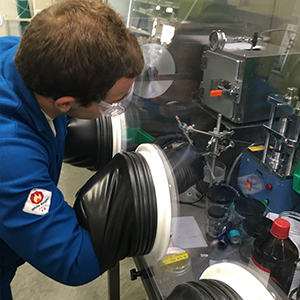
Abstract: Widespread commercialization of lithium metal battery technology has been prevented for decades by lithium dendrite growth, which is caused by uneven electrodeposition of lithium metal and can lead to short-circuiting. The goal of this project was to determine how various characteristics of the solid polymer electrolyte used in lithium metal batteries affect the timescales of dendrite growth and short-circuiting. The results so far indicate that the timescales of dendrite nucleation are affected by the chemical composition of the polymer electrolyte and not just its mechanical properties as previously thought.
Daniel Hardiman • University of Notre Dame
Prof. Jennifer Schaefer • Chemical & Biomolecular Engineering
Elucidating fundamental transport properties of co-polymer-derived charge mosaic membranes (Sushree Jagriti Sahoo)
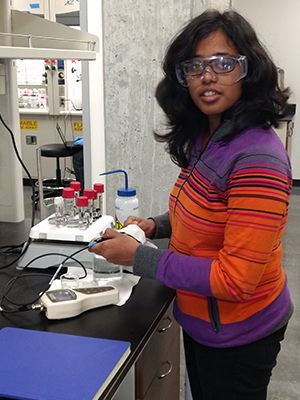
Abstract: The W.A.T.E.R lab has developed charge mosaic membranes that facilitate diffusion of charged solutes over water through oppositely charged regions. These are being fabricated by ink-jet printing polymeric materials onto a structural template. The CMMs are being printed by using the striped pattern which is alternatively printing positively charged and negatively charged polyelectrolytes. To develop an understanding of how these membranes function, we conducted diffusion cell experiments for salts of varying valency, having different concentrations and ionic mobility. Through the experimental water flow and solute throughput tests, we were able to elucidate how the nanoscale structure and chemical functionalities of the membranes impact the observed transport properties.
Sushree Jagriti Sahoo • Indian Institute of Technology, Delhi
Prof. William A. Phillip • Chemical & Biomolecular Engineering
Engineering multifunctional nanoparticles for targeted drug delivery in cancer (Kate Mockler)
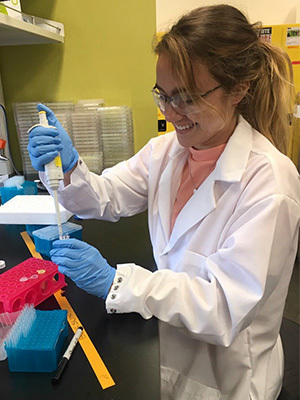
Abstract: Most cancer drugs fail in clinical studies not because they are ineffective in killing cancer cells, but because they cannot be administered in doses high enough to destroy the tumor without dangerously harming the patient. One potential solution to this problem is to encapsulate anticancer drugs in liposomal nanoparticles that selectively target only cancer cells. The conjugation of ligands to liposomes enables active targeting of the tumor through specific binding to tumor-associated receptors.
Kate Mockler • University College Dublin (Naughton REU)
Prof. Basar Bilgicer • Chemical & Biomolecular Engineering
Engineering optical modes in thin layers of epsilon-near-zero polar semiconductors (Zhaoyuan Fang)
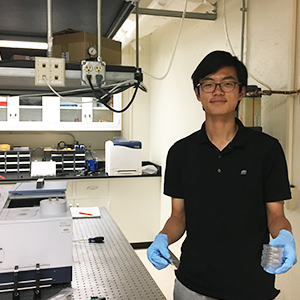
Abstract: We demonstrate how crystal vibrations, called phonons, can be leveraged to engineer optical modes in thin layers of polar semiconductors. We characterize coupling to the Berreman mode for four different samples using polarization-, angle- and wavelength-dependent reflection spectroscopy and compare the results to numerical models developed using rigorous coupled wave analysis and finite difference frequency domain techniques; there is good agreement between experiment and simulations. These materials could eventually be used to engineer fundamentally new optoelectronic devices for the mid- and far-IR.
Zhaoyuan Fang • University of Notre Dame
Prof. Anthony Hoffman • Electrical Engineering
Prof. Ryan K. Roeder • Aerospace & Mechanical Engineering
Engineering responsive peptide-based drug nanocarriers (Calvin Nazareth)
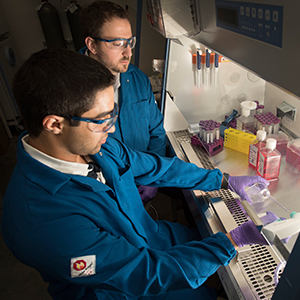
Abstract: Previously, we have established a library of amphiphilic that form nanostructures and gels. Near UV circular dichroism and infrared spectroscopy on the peptide gels show minimal signs of beta sheets. We developed analogous ‘tripeptoids’ to analyze the importance of hydrogen bonding in the peptide hydrogels. Peptoids have a side chain on the nitrogen rather than the carbon. Our peptoids did not form hydrogels however, they formed nanostructures similar to the peptides.
Calvin Nazareth • University of Notre Dame
Prof. Matthew J. Webber • Chemical & Biomolecular Engineering
Generation of polymeric shell encapsulating microdroplets by AC electrospray and fabrication of silicon nanopore array by inverted pyramid technique (Shivam Agarwal)
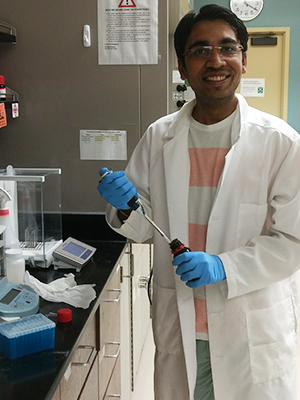
Abstract: We present the method to produce microdroplets encapsulated by styrene shell by AC electrospray method. We used the noble idea of ohmic heating generated due to applied electric field at the tip of capillary to polymerize the styrene thus forming the shell. We have also fabricated silicon nanopore array by inverted pyramid technique to achieve multi-target quantification of droplets.
Shivam Agarwal • Indian Institute of Technology, Delhi
Prof. Hsueh-Chia Chang • Chemical & Biomolecular Engineering
High-throughput spray coating of membranes for applications in desalination and waste chemical recovery (Mauricio Segovia)
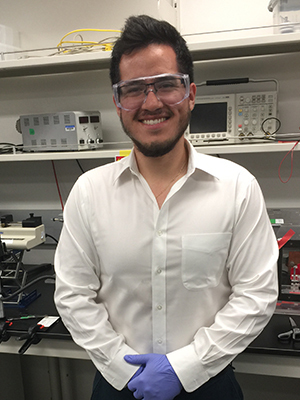
Abstract: Membranes are an important aspect of many water filtration systems. However, many membranes produced from conventional methods have one of two functions: filtration of contaminates based on their size or filtration of contaminates based on their chemistry. In order to produce a membrane with both of these function, nanoporous membranes based on self-assembled polymers have been shown to be a promising class of membranes. The research done this summer was to build two spraying techniques of thin-film deposition that utilized electric fields and to optimize the membrane performance based off of the spraying parameters.
Mauricio Segovia • University of Notre Dame
Prof. David Go • Aerospace & Mechanical Engineering
Prof. William A. Phillip • Chemical & Biomolecular Engineering
Monolayer thin film deposition of nanoparticles for analysis of optical properties (Bryce Beddard)
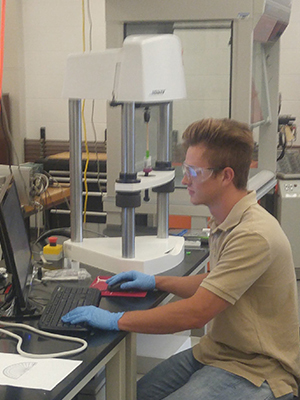
Abstract: Optical characterization of phononic nanoparticles is necessary to explore their potential applications in the mid- to far-IR spectrums. A robust dip coating process to develop monolayer thin films was designed. Various parameters were explored to increase the reliability and consistency of the process. These included adsorbed self assembled monolayers on the substrate, concentration of nanoparticles in suspension, and the volume of suspension used in each dip coat.
Bryce Beddard • Vanderbilt University
Prof. Anthony Hoffman • Electrical Engineering
Prof. Ryan K. Roeder • Aerospace & Mechanical Engineering
Predicting material elastic responses from molecular dynamics simulations (Nishi Kashyap)
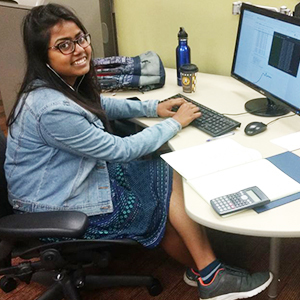
Abstract: Biological membranes play a very important role especially when it comes to functioning of living cells. They experience fluctuating properties like undulation of surface due to excitation at physiological temperatures which has a serious impact on their functioning. Clearly, being able to monitor their elastic properties holds a lot of significance. For studying these undulations in membranes, like, local protrusions and variable thickness, Helfrich-type continuum model,one of the most reliable method, has been applied using fourier transformation. All the results have been obtained on 1,2-dimyristoyl-sn-glycero-3-phosphocholine (DMPC).The study further includes analysis on multiple mixtures of Dipalmitoylphosphatidylcholine (DPPC), 1,2-(cis-cis-9,12-octadecadienoyl)-sn-glycero-3-phosphatidylcholine (DUPC) and Cholestrol.
Nishi Kashyap • Indian Institute of Technology, Delhi
Prof. Jonathan K. Whitmer • Chemical & Biomolecular Engineering
Recruitment of endogenous antibodies (Joseph Riehm)
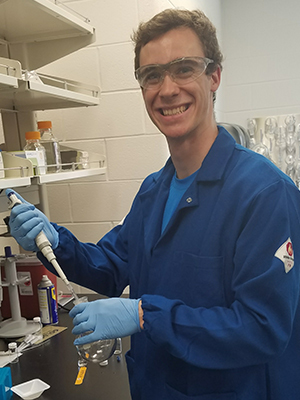
Abstract: The molecule under development is a proof of concept for a peptide that recruits antibodies naturally present in humans to a chosen cell receptor, marking the cell for destruction by the immune system. A series of molecules were designed to multivalently target, thus promoting a covalent conjugation to an antibody and, with a second targeting moiety, attach to another antibody or cell receptor. This complex is designed to securely mark the cell for destruction.
Joseph Riehm • University of Notre Dame
Prof. Basar Bilgicer • Chemical & Biomolecular Engineering
Synthesis and characterization of novel electrolytes for rechargeable batteries (Alisha Agrawal)
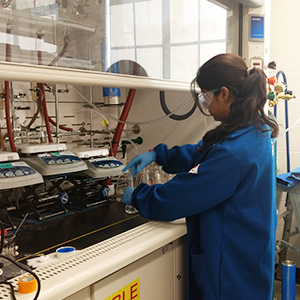
Abstract: Polymer electrolytes have been in demand since solid state batteries were discovered. In addition to ease of processing, they have good mechanical properties and high chemical, electrochemical and photochemical stability. It is highly desirable to create high conductivity polymers which can be facilitated by engineering microstructures. This project includes the synthesis and study of small novel electrolytes such as lithium alkyl salts which can be used to study transport and phase transition(s) with an eye towards application in polymer electrolytes. After synthesis, elemental analysis, DSC and dielectric measurements were carried out for characterization. The effect of electrolyte composition on properties like conductivity and thermodynamics was studied. Simultaneously, changes in volume and enthalpy with respect to temperature were examined in atomistic molecular dynamics simulations to validate the phase transitions observed in experiments. Future work on these materials will involve stabilization by polymerization in order to lend mechanical stability to these phases.
Alisha Agrawal • Indian Institute of Technology, Delhi
Prof. Jennifer Schaefer • Chemical & Biomolecular Engineering
Prof. Jonathan Whitmer • Chemical Biomolecular Engineering
Synthesis of peptidic derivatives of 1,3,5-benzenetricarboxamide and investigation of their supramolecular assembly (William McCarthy)
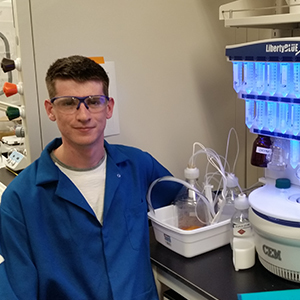
Abstract: Supramolecular self-assembly describes a process of molecular recognition and organization into defined structures using specific, directional, non-covalent interactions. Supramolecular structures can lead to materials with dynamic, responsive and highly tuneable properties that have application in drug delivery, tissue engineering and regenerative medicine among many others. We are specifically interested in illustrating the utility of creating supramolecular biomaterials arising from the 1,3,5-benzenetricarboxamide (BTA) hydrogen bonding motif. Specifically, through appendage of peptides to the BTA core, it is our objective to create hydrogels which may be useful as biomaterials.
William McCarthy • Trinity College Dublin (Naughton REU)
Prof. Matthew J. Webber • Chemical & Biomolecular Engineering
Targeted asparaginase for improved treatment of pediatric leukemia (Siena Mantooth)
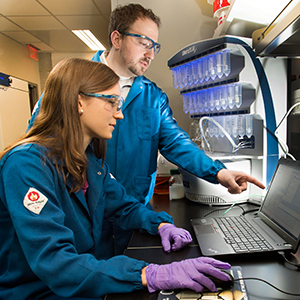
Abstract: We sought to target the drug L-Asparaginase to lymphoblastic leukemia cells. Thus, we have explored routes to modify L-Asparaginase through bioconjugation for attachment of minimal supramolecular affinity motifs. Simultaneously, we are modifying tissue-specific labeling moieties with the complementary portion of these affinity motifs. Thus, a cell or tissue of interest could be labeled with one half of the affinity motif, which would subsequently serve to home the modified enzyme to this site through a supramolecular affinity axis.
Siena Mantooth • University of Notre Dame
Matthew J. Webber • Chemical & Biomolecular Engineering
Adjustable photonics of SiO2-Au core-shell nanoparticles (Kyle Iwamoto)
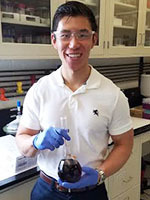
Kyle Iwamoto • University of Notre Dame
Prof. Ryan K. Roeder • Aerospace & Mechanical Engineering
Complex coacervates and the effects of chain length on critical properties (AJ Zervoudakis)
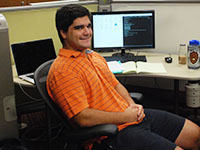
Aristotle Zervoudakis • University of Notre Dame
Prof. Jonathan K. Whitmer • Chemical & Biomolecular Engineering
Designing hyperbolic metamaterials using polar III-nitride semiconductors (Thomas Witte)
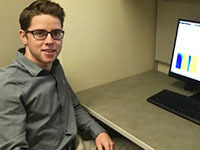
Thomas Witte • University of Notre Dame
Prof. Anthony Hoffman • Electrical Engineering
Development of a chemical sensor for fluid dynamic applications (Arnau Rodriguez Rubio)
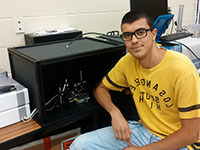
Arnau Rodriguez Rubio • Universitat Rovira i Virgili
Prof. Hirotaka Sakaue • Aerospace & Mechanical Engineering
Estimation of Qubit and other Hamiltonians (Sushrut Ghonge)
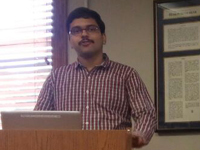
Sushrut Ghonge • Indian Institute of Technology-Delhi
Prof. Dervis Vural • Physics
Fabrication methods of solid state battery electrolytes (Liam McDermott)

Liam McDermott • McMaster University (Summer Exchange Program)
Prof. Paul McGinn • Chemical & Biomolecular Engineering
Fabrication of polymer nanofibers with anomalous thermal conductivity (Manikandan Suresh)
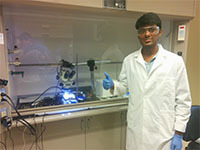
Manikandan Suresh • Birla Institute of Technology, Mesra
Prof. Tengfei Luo • Aerospace & Mechanical Engineering
Fabrication of polymer nanofibers with anomalous thermal conductivity (Peter Hanly)
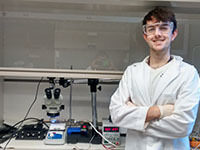
Peter Hanly • University College Dublin (Naughton REU)
Prof. Tengfei Luo • Aerospace & Mechanical Engineering
High-speed terahertz near-field imaging with optical imaging resolution (Talha Choudhry)
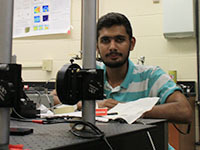
M. Talha Choudhry • Pakistan Navy Engineering College
Prof. Lei Liu • Electrical Engineering
Identifying nanostructure in medieval manuscripts (Thomas Clarke)
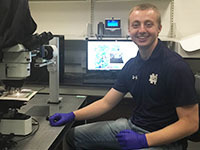
Thomas Clarke • University of Notre Dame
Prof. Zachary Schultz • Chemistry & Biochemistry
Immunotargeted nanoparticles bind to cancer cells (Joseph Sawyer)
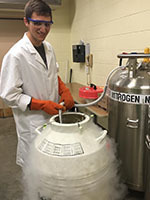
Joseph Sawyer • Purdue University
Prof. Ryan K. Roeder • Aerospace & Mechanical Engineering
Implementing selective swelling agents to tailor the nanostructure and transport properties of self-assembled copolymer membranes (Jin Kim)
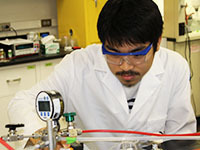
Jin Kim • University of Notre Dame
Prof. William A. Phillip • Chemical & Biomolecular Engineering
Light transmission spectroscopy for the sizing of nanoparticles in suspension (Frances Ryan)
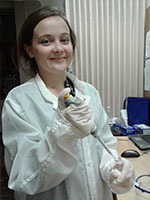
Frances Ryan • Dublin City University (Naughton REU)
Prof. Steve Ruggiero • Physics
Prof. Carol Tanner • Physics
Light transmission spectroscopy (LTS): A new bio-molecular tool (Roland Rebuyon)
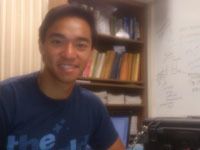
Roland Rebuyon • University of Notre Dame
Prof. Steve Ruggiero • Physics
Prof. Carol Tanner • Physics
Magnetoelectric nanoparticles to specifically target cancer cells in vitro (Andrea Oviedo)
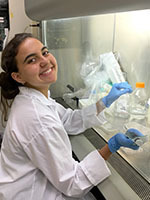
Andrea Oviedo • University of Notre Dame
Dr. Tiffanie Stewart • NDnano
Microperforation of silicon wafers for variable permittivity (Nicolas Garcia)
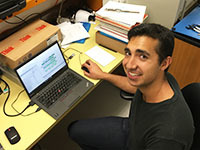
Nicolas Garcia • University of Notre Dame
Professor Jonathan Chisum • Electrical Engineering
Professor Patrick Fay • Electrical Engineering
Professor Lei Liu • Electrical Engineering
Non-invasive quantification of biomaterial degradation using nanoparticle imaging probes (James Tedesco)
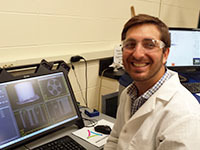
James Tedesco • McMaster University (Summer Exchange Program)
Prof. Ryan K. Roeder • Aerospace & Mechanical Engineering
Penetrating cancerous multiceullar aggregates with magnetoelectric nanoparticles (Rachel Hanley)
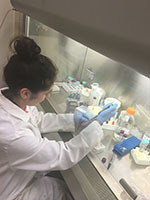
Rachel Hanley • Dublin City University (Naughton REU)
Dr. Tiffanie Stewart • NDnano
Polymer electrolytes for advanced rechargeable batteries (Vasu Tekriwala)
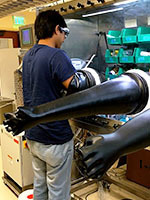
Vasu Tekriwala • Indian Institute of Technology-Delhi
Prof. Jennifer Schaefer • Chemical & Biomolecular Engineering
Production of magnetoelectric nanoparticles and functionalization for increased biocompatibility (Eoin O'Sullivan)
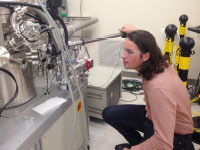
Eoin O'Sullivan • Trinity College Dublin (Naughton REU)
Dr. Tiffanie Stewart • NDnano
Tailoring the chemistry of copolymer-based embrane adsorbers for heavy metals removal via high-throughput evaluation techniques (Ryan LaRue)

Ryan LaRue • McMaster University (Summer Exchange Program)
Prof. William A. Phillip • Chemical & Biomolecular Engineering
The role of methylammonium cations in perovskite solar cells (Charles Marchant)
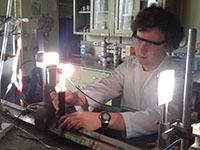
Charles Marchant • University College Dublin (Naughton REU)
Prof. Prashant V. Kamat • Chemistry & Biochemistry
Waste-to-Value: Simultaneous wastewater treatment and energy production using solar photoelectrochemical fuel cells (Juan Velazquez)
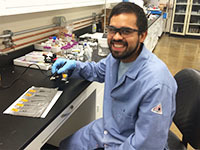
Juan Velazquez • University of Notre Dame
Prof. Kyle Doudrick • Civil and Envirionmental Engineering & Earth Sciences
Analyzing fictional participatory governance scenarios with automated text analysis (Justin Stamets)
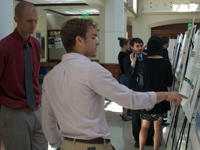
Justin Stamets • Indiana University
Prof. Kathleen Eggleson • NDnano
A screen for siRNA nanoparticle pesticides to target mosquito vectors of human disease (Megan Kilbride)
Megan Kilbride • University of Notre Dame
Prof. Molly Duman Scheel • Biological Sciences & IU School of Medicine-South Bend
Biocomplexity and uncertainty: Science, technology, and ethics in the real-world case of metal nanoparticles in heavy commercial use (Joshua Dempsey)
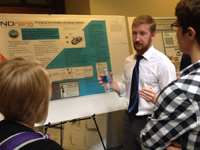
Joshua Dempsey • University of Notre Dame
Prof. Kathleen Eggleson • NDnano
Coordination chemistry of the CH3NH3PbI3 perovskite precursor solution (Tessa Ronan)
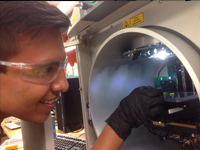
Tessa Ronan • Dublin City University (Naughton REU)
Prof. Prashant V. Kamat • Chemistry Biochemistry
Demonstration of light sources and solar cells for introductory course in electrical engineering (Anthony Hanner)
Anthony Hanner • Indiana University South Bend
Prof. Gary Bernstein • Electrical Engineering
Efficient upconversion in solar cells (Albert Pucci)
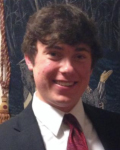
Albert Pucci • University of Notre Dame
Prof. Mark Wistey • Electrical Engineering
Engineering the linear stability of ray trajectories in highly compact chaotic multipass cells (Luis Cortes Herrera)
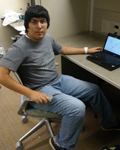
Luis Cortes Herrera • Tecnológico de Monterrey
Prof. Anthony Hoffman • Electrical Engineering
Gadolinium nanoparticle contrast agent for MRI/CT dual mode imaging (Patricia Sosa Silva)
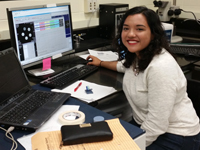
Patricia Sosa Silva • Tecnológico de Monterrey
Prof. Ryan K. Roeder • Aerospace & Mechanical Engineering
Initial study and demonstration of terahertz adaptive wireless communication (SeungGoo Kang)
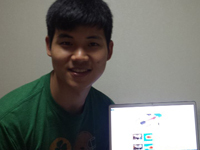
SeungGoo Kang • University of Notre Dame
Prof. Lei Liu • Electrical Engineering
Interdisciplinary research of chemical sensor development for fluid dynamic applications (Daiki Kurihara)
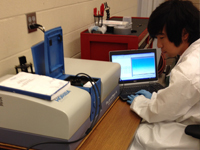
Daiki Kurihara • Tokyo University of Science
Prof. Hirotaka Sakaue • Aerospace & Mechanical Engineering
Light transmission spectroscopy: A new bio-molecular tool (Roland Rebuyon)
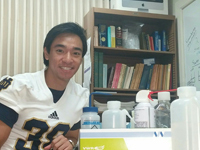
Roland Rebuyon • University of Notre Dame
Prof. Steve Ruggiero • Physics
Prof. Carol Tanner • Physics
Maximizing the potential of energy transfer in squaraine dye / CdSe quantum dot hybrid solar cells (Isaac Wappes)
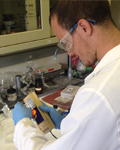
Isaac Wappes • University of Notre Dame
Prof. Prashant V. Kamat • Chemistry & Biochemistry
Micro-maker system for custom printed electronics (Maxwell Kennard)
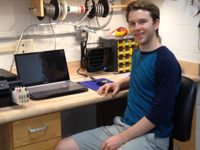
Maxwell Kennard • University of Notre Dame
Prof. David Hoelzle • Aerospace & Mechanical Engineering
Modelling aging in complex networks (Sushrut Ghonge)

Sushrut Ghonge • Indian Institute of Technology Delhi
Prof. Dervis Vural • Physics
Nanoelectronics from two-dimensional materials (Rigel Galindo Esparza)
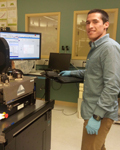
Rigel Galindo Esparza • Tecnológico de Monterrey
Prof. Alan Seabaugh • Electrical Engineering
Nanoparticle contrast agents for spectral computed tomography (Anthony Goo)

Anthony Goo • University of Notre Dame
Prof. Ryan K. Roeder • Aerospace & Mechanical Engineering
Nanoparticle synthesis for fabrication of 3D solid-state batteries (Michael Junker)
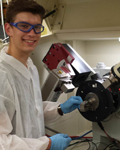
Michael Junker • University of Notre Dame
Prof. Paul McGinn • Chemical & Biomolecular Engineering
Nano-structured arrays for sustainable water treatment technologies (Darragh Lombard)
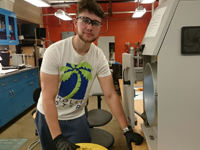
Darragh Lombard • University College Cork (Naughton REU)
Prof. Kyle Doudrick • Civil & Environmental Engineering and Earth Sciences
Nano-structured arrays for sustainable water treatment technologies (Diego Rosas Villalva)

Diego Rosas Villalva • Universidad de las Américas Puebla
Prof. Kyle Doudrick • Civil & Environmental Engineering and Earth Sciences
Non-Boolean computing using nanodevices (Emily Song)
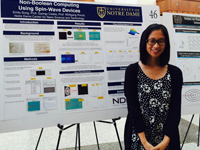
Emily Song • Columbia University
Prof. Gyorgy Csaba • Electrical Engineering
Prof. Wolfgang Porod • Electrical Engineering
Non-Boolean computing using nanodevices (Nicholas Salay)
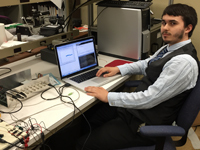
Nicholas Salay • Purdue College of Technology
Prof. Gyorgy Csaba • Electrical Engineering
Prof. Wolfgang Porod • Electrical Engineering
Perovskite solar cell (Sooraj Ben Kallarackal Rajan)
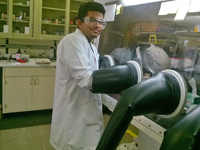
Sooraj Ben Kallarackal Rajan • Indian Institute of Science Education and Research, Thiruvananthapuram (S.N. Bose Scholar)
Prof. Prashant V. Kamat • Chemistry & Biochemistry
Picometer-diameter pore-based protein sequencing (Clare Tennant)
Clare Tennant • University of Notre Dame (Clare Boothe Luce Undergraduate Research Fellow)
Prof. Gregory Timp • Electrical Engineering and Biological Sciences
Prof. Tetsuya Tanaka • Biological Sciences
Plasma jets for nanomaterials synthesis (Jorge Ramirez)
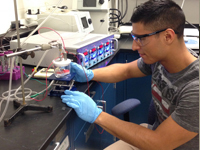
Jorge Ramirez • University of Texas El Paso
Prof. David Go • Aerospace & Mechanical Engineering
Removing surface residue from graphene via CO2 annealing (Edward Hunckler)
Edward Hunckler • University of Notre Dame (NSF REU)
Prof. Susan Fullerton • NDnano & Electrical Engineering
Prof. Alan Seabaugh • Electrical Engineering
Repair of and research with a scanning electron microscope (Austin Cullison)
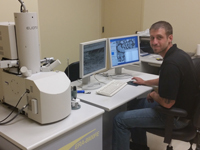
Austin Cullison • Purdue College of Technology
Prof. Gary H. Bernstein • Electrical Engineering
Selective inhibition of allergic responses and autoimmunity (Maura Vrabel)
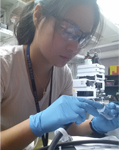
Maura Vrabel • University of Notre Dame (Clare Boothe Luce Undergraduate Research Fellow)
Prof. Basar Bilgicer • Chemical & Biomolecular Engineering
SERS detection of glucose phosphate isomers (Colleen Riordan)
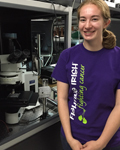
Colleen Riordan • University of Notre Dame (Clare Boothe Luce Undergraduate Research Fellow)
Prof. Zachary Schultz • Chemistry & Biochemistry
Signal processing using LC lattice microwave networks (Áine Cahill)
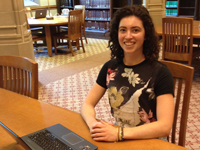
Áine Cahill • Trinity College Dublin (Naughton REU)
Prof. Gyorgy Csaba • Electrical Engineering
Prof. Wolfgang Porod • Electrical Engineering
Spatially patterned microfabricated co-cultures to study cancer development and progress (Jack Casey)

Jack Casey • University of Notre Dame
Prof. Pinar Zorlutuna • Aerospace & Mechanical Engineering
Stochastic computing with nanomagnet logic (NML) (Katherine Sanders)

Katherine Sanders • University of Notre Dame
Prof. Sharon Hu • Computer Science & Engineering
Thermal properties of polyvinyl alcohol (PVA):LiClO4 electrolytes for room temperature doping of 2D crystal transistors (Ashley Fuller)
Ashley Fuller • Saint Mary's College/University of Notre Dame
Prof. Susan Fullerton • NDnano & Electrical Engineering
Thermal rectification in a hexadecane-paraffin wax junction (Brian Buechler)
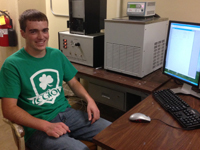
Brian Buechler • University of Notre Dame
Prof. Tengfei Luo • Aerospace & Mechanical Engineering
Toxicity studies of nanoparticles (Jennifer Diamond)
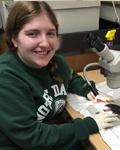
Jennifer Diamond • University of Notre Dame
Prof. Paul Huber • Chemistry & Biochemistry
Ultra-low energy computation (Cleo Harvey)
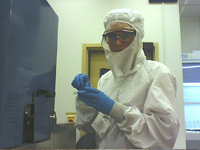
Cleo Harvey • Dublin City University (Naughton REU)
Prof. Gregory Snider • Electrical Engineering
Ultra-low energy computation (Sergio Dieck Sa)
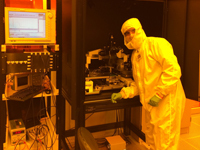
Sergio Dieck Sa • Tecnológico de Monterrey
Prof. Gregory Snider • Electrical Engineering
YAP and TAZ effects on bone formation (James Dawahare)
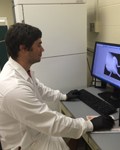
James Dawahare • University of Notre Dame
Prof. Joel Boerckel • Chemical & Biomolecular Engineering
Approaching real-time photo-induced THz coded aperture imaging using compressed sensing (Sakshi Singh)

Sakshi Singh • Amrita University
Prof. Lei Liu • Electrical Engineering
Artificial tissue formation using laser-based optical tweezers (Steven Penny)
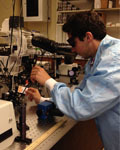
Steven Penny • University of Notre Dame
Prof. Gregory Timp • Electrical Engineering and Biological Sciences
Prof. Tetsuya Tanaka • Biological Sciences
Biocomplexity and uncertainty -- Science, technology and ethics in the real-world case of metal nanoparticles in heavy commercial use (Joshua Dempsey)

Joshua Dempsey • University of Notre Dame
Dr. Kathleen Eggleson • NDnano
Depositing and characterizing two-dimensional materials for low-voltage memory (Katie O'Neill)
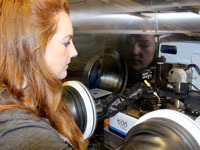
Katie O'Neill • Trinity College Dublin
Prof. Susan Fullerton • NDnano and Electrical Engineering
Design and characterization of ultrafast chip-to-chip interconnects (Xinyi Wang)
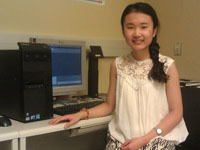
Xinyi Wang • University of Notre Dame
Prof. Patrick Fay • Electrical Engineering
Design and evaluation of CNN-based circuits using beyond-CMOS devices (Arsal Habib)
Arsal Habib • Union College
Prof. Sharon Hu • Computer Science & Engineering
Prof. Michael Niemier • Computer Science & Engineering
DNA origami (Keenan Linder)
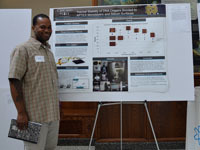
Keenan Linder • Chicago State University
Prof. Marya Lieberman • Chemistry & Biochemistry
Dr. Valerie Goss • Chemistry & Biochemistry
DNA origami (Rose Doerfler)
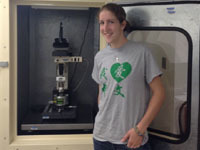
Rose Doerfler • University of Notre Dame
Prof. Marya Lieberman • Chemistry & Biochemistry
Dr. Valerie Goss • Chemistry & Biochemistry
Engineering multifunctional nanoparticles for targeted drug delivery In cancer (Vincenzo Pizzuti)
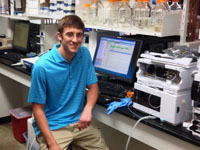
Vincenzo Pizzuti • University of Notre Dame
Prof. Basar Bilgicer • Chemical & Biomolecular Engineering
Graphene-based assemblies for the detection and photocatalytic degradation of contaminants (Barry Reid)
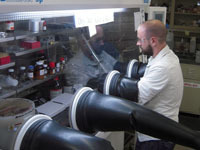
Barry Reid • Dublin City University (Naughton Fellow)
Prof. Prashant Kamat • Chemistry & Biochemistry
Integrated platform for nucleic acid sensing (Robin Lawler)
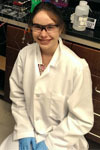
Robin Lawler • University of Notre Dame
Prof. Hsueh-Chia Chang • Chemical & Biomolecular Engineering
Nanoelectronics from two-dimensional materials (Buchanan Bourdon)
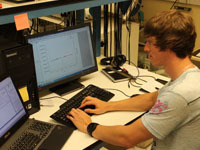
Buchanan Bourdon • University of Notre Dame
Prof. Alan Seabaugh • Electrical Engineering
Nanoelectronics from two-dimensional materials (Patrick Foley)

Patrick Foley • University College Cork (Naughton Fellow)
Prof. Alan Seabaugh • Electrical Engineering
Nano-optics of electronic molecules (Anuj Kumar)
Anuj Kumar • Indian Institute of Technology Delhi
Prof. Alexander Mintairov • Electrical Engineering
Nanoparticle contrast agents for detecting damaged cartilage (Katherine Iliff)
Katherine Iliff • University of Notre Dame
Prof. Ryan Roeder • Aerospace & Mechanical Engineering
Prof. Diane Wagner • Aerospace & Mechanical Engineering
Nanoparticle contrast agents for spectral (color) X-ray imaging (Margaret Best)
Margaret Best • University of Notre Dame
Prof. Ryan Roeder • Aerospace & Mechanical Engineering
Non-Boolean computing using nanodevices (Quinn O'Rourke)
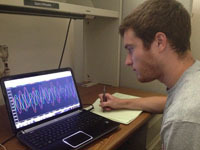
Quinn O'Rourke • University of Notre Dame
Prof. Wolfgang Porod • Electrical Engineering
Prof. György Csaba • Electrical Engineering
Non-Boolean computing using nanodevices (Robert Frame)
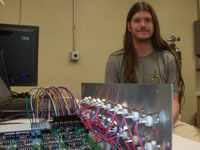
Robert Frame • Purdue College of Technology
Prof. Wolfgang Porod • Electrical Engineering
Prof. György Csaba • Electrical Engineering
Non-Boolean computing using nanodevices (Sam O'Mahony)
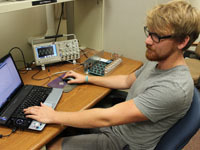
Sam O'Mahony • University College Cork (Naughton REU)
Prof. Wolfgang Porod • Electrical Engineering
Prof. György Csaba • Electrical Engineering
Plasma jets for nanomaterials synthesis (Nathaniel Griggs)

Nathaniel Griggs • University of Notre Dame
Prof. David Go • Aerospace & Mechanical Engineering
Plasma jets for nanomaterials synthesis (Santiago Martinez)
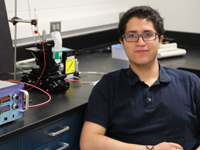
Santiago Martinez • University of Notre Dame
Prof. David Go • Aerospace & Mechanical Engineering
Quantum dot solar cell (Abigail Swint)
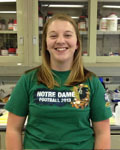
Abigail Swint • University of Notre Dame
Prof. Prashant Kamat • Chemistry & Biochemistry
Restrahlen band optics with surface phonon polaritons (Luis Cortes Herrera)
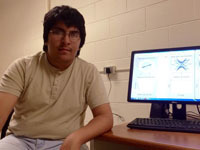
Luis Enrique Cortes Herrera • Tecnológico de Monterrey
Prof. Anthony Hoffman • Electrical Engineering
Simulation of upconverting nanostructures (Matthew Henne)
Matthew Henne • University of Notre Dame
Prof. Mark Wistey • Electrical Engineering
Stochastic computing and nanomagnet logic (Katherine Sanders)
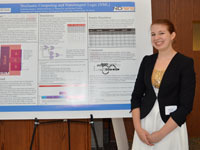
Katherine Sanders • University of Notre Dame
Prof. Sharon Hu • Computer Science & Engineering
Prof. Michael Niemier • Computer Science & Engineering
Surface enhanced raman detection of glycans (Colleen Riordan)
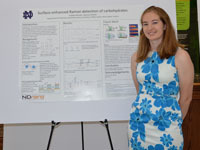
Colleen Riordan • University of Notre Dame
Prof. Zachary Schultz • Chemistry & Biochemistry
Two-dimensional semiconductors: New toys for the next nano(opto) electronics era (Katrina Magno)
Katrina Magno • University of Notre Dame
Prof. Huili Grace Xing • Electrical Engineering
Prof. Debdeep Jena • Electrical Engineering
Ultra-low energy computation (Rene Celis Cordova)
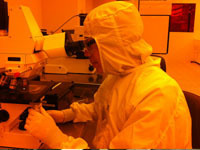
Rene Celis Cordova • Tecnológico de Monterrey
Prof. Gregory Snider • Electrical Engineering